Despite the massive number of kaiju films released in 1967, most of them aren't particularly memorable. Many were new entrants into the field by studios that had never endeavored to make a giant monster film before. Even Toho's franchise was running out of steam, with the disappointing performance of Son of Godzilla, as well as the flooded market. Godzilla just wasn't as special as he had been. To celebrate the 15th anniversary of the Godzilla franchise in 1968, Toho decided to get the band back together.
And with immaculate timing, my DVD player has decided it no longer likes my copy. Pictures will come later, sadly.
Destroy all Monsters is the last film with the five original artists from Godzilla; Ishiro Honda, Eiji Tsuburaya (although only in an honorary fashion, he was very ill as this time), Tomoyuki Tanaka as producer, Haruo Nakajima in the suit, and Akira Ifukube writing the music. Some call this the end of an era, but to my mind, it's a Hercluean effort before economic and social forces turned the kaiju film into a cheap and poorly thought-out spectacle.
The year is 1999, and as in several previous films, Japan (or, really UNSC) has a space program. They have also managed to confine all the monsters to a location, Monster Land. The space program trope fades a bit after the excitement of the space race cooled off, but the Monster Island idea is one that stuck with the franchise until the end of the Shōwa era. Moonlight SY-3 is a stylish, almost art deco spacecraft, combining attributes of a high-tech jet as well as a rocket.
Ogasawara Island, called Monster Land, is the culmination of several ideas previous films, such as Mothra vs Godzilla and Ebirah, Horror of the Deep. Although the monsters are not under human control, they are at least confined. If Godzilla and the other monsters are still seen as a metaphor for nuclear testing, this may coincide with the rise of nuclear power in Japan, with the Mihama Nuclear Power Plant beginning construction outside Tokyo in February of 1967. On the other hand, this is the ultimate expression of Dr. Serizawa's desire to study the monsters. Now that they are controlled, they can be understood.
The Kilaaks, the alien antagonists, can control the monsters. Japan can never do so, merely containing the monsters, but alien invaders and terrorist corporations such as the Red Bamboo seek to control the giant monsters for their own ends. Ghidorah is, again, the puppet of an alien intelligence just as he was for the Xiliens and the Futurans. They are all female, all Japanese-looking (despite the more international bent of the film) but this is a disguise. They really look like slugs, and are made of 'living metal.' It turns out that they can control humans just as easily as they can monsters. This creates a paranoia in the film similar to the 1956 film Invasion of the Body Snatchers. Anyone could be a Kilaak agent (until they discover the transmitters which allow the Kilaaks to control humans and monsters).
Strangely, Mothra has shed her unique status as protector of Infant Island, and has been confined in the same way that the other monsters have. Also gone from this film are her twins, the Shobijin, Mothra's interface with humanity. She's just another destructive monster. She's also back in larval form. It's possible (pardon me while I fan-theory) that this is the other larva that hatched in Godzilla vs Mothra and didn't become the Mothra we saw in Ebirah, Horror of the Deep, which I assume is the peacemaker from Ghidorah, the Three-Headed Monster.
The film is very much a retread of the tropes and ideas from Ghidorah. Alien invaders, all the monsters ultimately ganging up against Ghidorah, Godzilla pulling a turn from implacable enemy to unstoppable hero. But where Ghidorah has three monsters attacking the three-headed monster, some seven attack him here. More spectacular, sure, but not as challenging a fight. But more than any previous film, Destroy All Monsters takes a look at the international problem of monsters. Rodan attacks Moscow. Gorasaursus, unseen since King Kong Escapes stands in for Baragon, who was on loan to Tsubaraya's Ultraman. Which is why it is misidentified, as well as shows some rather unlikely tunneling abilities. We are told that Mothra attacks Beijing, and that Manda attacks London, but we don't see these. We do see Godzilla show up in New York harbor and blast the United Nations building with his radioactive breath. 1998 Godzilla is not the first time the big guy took a bite out of the Big Apple.
In the middle of the film (XXX minutes), we have a beautiful miniature of 1999 Tokyo. Small card move along her streets, an elevated train trundles along tracks. The set is large and took a lot of attention to detail. Ironic, really that the construction boom made Tokyo so much more impressive thirty years later. The destruction of Tokyo by Godzilla, Rodan, Manda, and Mothra is beautiful in its mayhem.
For the first time since Godzilla Raids Again, the camera pans over the charred and ruined city. This was one of the most effective shots of the original Godzilla film, and it's a reminder that these films aren't completely fun and games. But it's brief, and the devastation isn't as total as it was in 1954.
Part of the bigger budget for this film shows in the miniatures. The military vehicles are a bit more fanciful, including tanks with missiles on their turrets and strange-looking radar antennae. It's as ineffective as the military always is, but it's a pleasure to see some fantasy deigns come from Tsubaraya's studio. There is also the implication, and a prescient one, that the tanks are drones.
The last battle happens, again like Ghidorah, in front of Mount Fuji, where the Kilaak base is. This is our only glimpse of Baragon in the fight, mostly through a thicket. We get a better shot of him in the farewell section, however.
But you have to wonder what the Kilaaks were thinking when they deployed Ghidorah. Godzilla, Rodan, and Mothra got rid of him last time, now Gorosaurus, Anguirus, Manda, Baragon, Varan and Kumonga (I'm not counting Minilla as a threat) are added to the team. It makes for a more impressive fight, but the outcome is pretty inevitable. Godzilla and Anguirus do most of the heavy lifting (the footage of Ghidorah flying with Anguirus firmly attached to one of its necks will be repeated a few times in later films) in the fight.
Once the fight is over, the Kilaaks deploy their Fire Dragon, a flying saucer burning with energy. Even though Godzilla puts an enormous foot through the Kilaak base, the Fire Dragon keeps coming. Ghidorah's inert body falls into the earth, similar to the way Frankenstein and Baragon ended. Only with more explosions, but it's up to the humans to solve the last problem. Which they do with Moonlight SY-3. This represents a major shift in attitude from Toho's previous films. Honda, who experienced WWII, had never allowed the military solution to be anything but show before this. And, although the conclusion is rooted in science fiction, Moonlight SY-3 fires missiles, causing the saucer to go down. The humans have taken the lead, controlling the monsters, no longer the ir helpless victims.
Destroy All Monsters was intended as a finale to the series, the end of monster films. However, it was so successful (admittedly selling only a hundred thousand tickets more than Son of Godzilla), but in a period of sharply declining attendance, this was seen as a major coup. And so the series continued, albeit with declining budgets.
Next up, Boy Scouts in trouble, and loaded with stock footage.
The personal blog of John Goodrich, including, but not limited to kaiju film and comics involving swamp creatures.
Thursday, December 26, 2013
WHAM! POW! BASH! DESTROY ALL MONSTERS
Thursday, December 19, 2013
Space Monster Wangmagwi the Easily Pronouncable
It turns out that Korea didn't produce one native kaiju film in 1967, they produced two. Ujugoe-in Wangmagwi is an unreleased monster film made entirely in Korea, and released a few months before Yonggary. Unlike Yonggary, Wangmagwi was an entirely Korean production. It was believed lost until a copy was discovered in the last decade. It is still undergoing restoration.
Which means I can't watch it. There are a few descriptions of it, and a couple of pictures, but opinions differ. The most complete description of the creature comes from Koreanfilm.com, which makes it sound both different from the usual run of monster films, while retaining many familiar tropes.
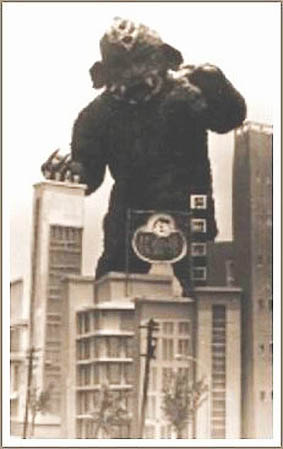
Aliens invade and create the giant monster Wangmagwi, which tromps through downtown Seoul. Ahn Hee, who is due to marry an air force pilot that day (shades of Yonggary) stays in town to wait for him, and it picked up by the monster (very King Kong and carried about. After Seoul is levelled, the monster moves to the countryside, where it can finally be confronted by the military. One very different piece introduced by the film, very different from other monster films, is a himeless boy nicknamed Squirrel. Cornered, Squirrel leaps onto Wangmagwi, climbs into his ear, and attacks the creautre with a knife. What effect this has on the monster, I don't know.
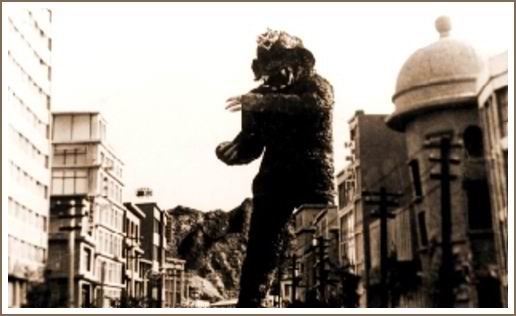
It also seems that Wangmagwi ow some design inspiration to Creature from the Black Lagoon. It's scaly, and spends a lot of time hauling a woman around.
Beyond that, I can only hope that the film gets restored and is released on DVD. I know that I'm not alone in this.
Your Boxing Day present, will be 1968's classic Destroy All Monsters. And that's going to be a load of fun.
Which means I can't watch it. There are a few descriptions of it, and a couple of pictures, but opinions differ. The most complete description of the creature comes from Koreanfilm.com, which makes it sound both different from the usual run of monster films, while retaining many familiar tropes.

Aliens invade and create the giant monster Wangmagwi, which tromps through downtown Seoul. Ahn Hee, who is due to marry an air force pilot that day (shades of Yonggary) stays in town to wait for him, and it picked up by the monster (very King Kong and carried about. After Seoul is levelled, the monster moves to the countryside, where it can finally be confronted by the military. One very different piece introduced by the film, very different from other monster films, is a himeless boy nicknamed Squirrel. Cornered, Squirrel leaps onto Wangmagwi, climbs into his ear, and attacks the creautre with a knife. What effect this has on the monster, I don't know.

It also seems that Wangmagwi ow some design inspiration to Creature from the Black Lagoon. It's scaly, and spends a lot of time hauling a woman around.
Beyond that, I can only hope that the film gets restored and is released on DVD. I know that I'm not alone in this.
Your Boxing Day present, will be 1968's classic Destroy All Monsters. And that's going to be a load of fun.
Thursday, December 12, 2013
It (Mostly) Came From Korea: Yonggary
What amazes me so much about Yonggary (1967) is how startlingly it resembles other films released in the same year. Yonggary is a South Korean production and used some of the special effects guys from Daiei. As a result, Yonggary looks a bit familiar with his large lower jaw fangs (shades of Gamera, a blowtorch breath weapon (Gamera Again), and a glowing horn (shades of Barugon. The film also has an annoying child as a protagonist.
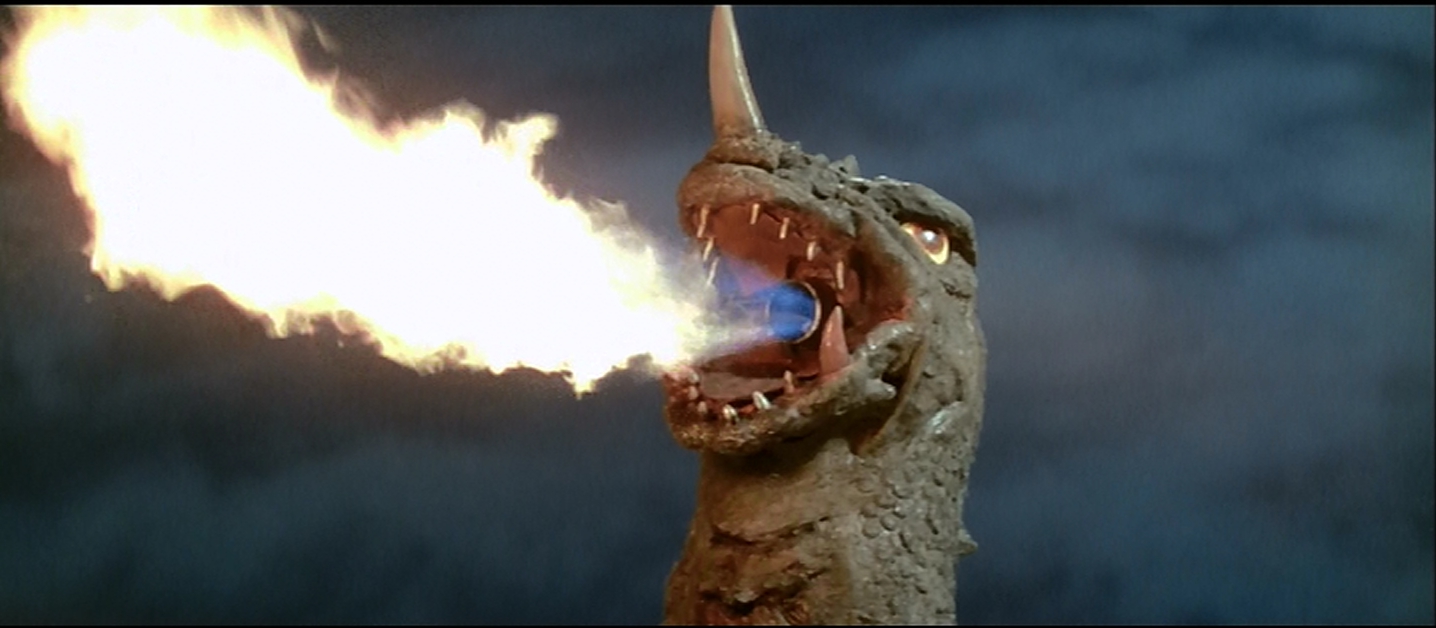
But early on, the film feels a lot like Giant Space Monster Guilala or Invasion of Astro-Monster, because South Korea has a manned space program. This is, oddly, a deal breaker for some reviewers, who consider it ridiculous. But a film-maker from a country that had no space program in the 60's really didn't have much choice. Either they could make everyone involved in the program American or Russian, but where were they going to find that many American or Russian actors, and why would they all be speaking Korean or Japanese? But beyond that, kaiju films are a mix of science fiction and fantasy, and why shouldn't a country which is proud of its achievements, dream that one day they will also reach for the stars?
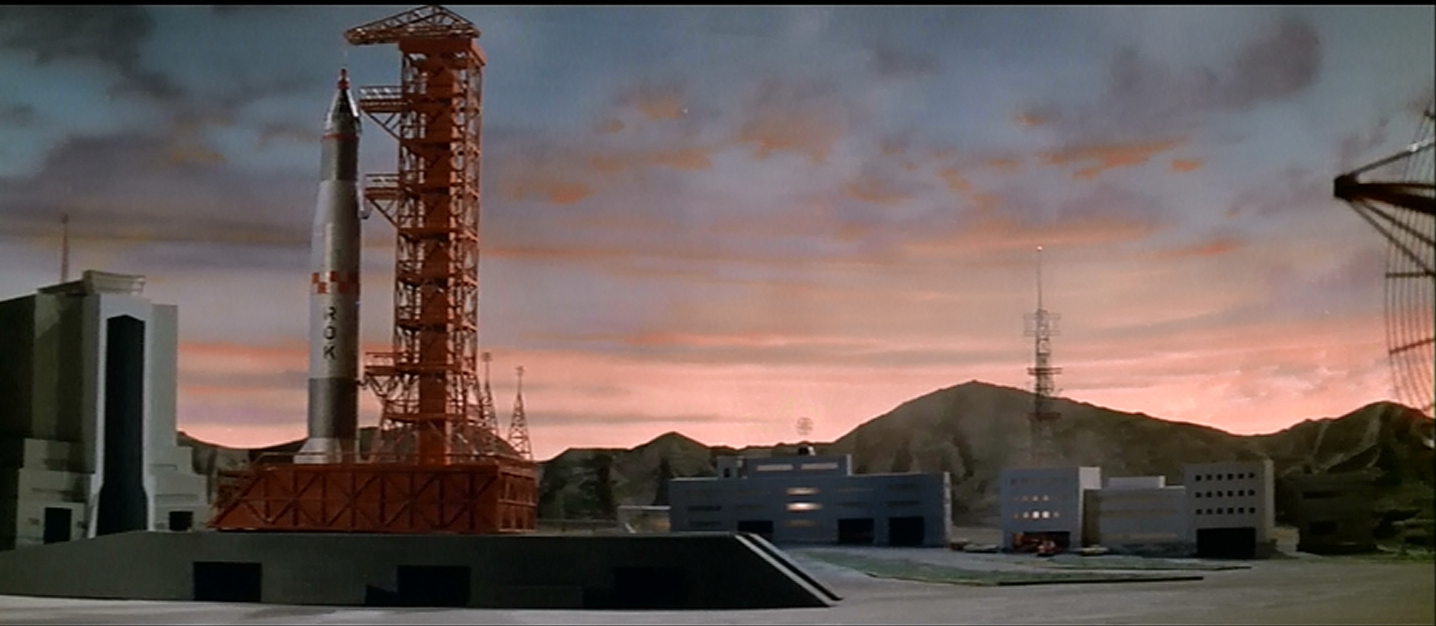
Unfortunately, the Korean cut of this film has been lost. All that I can access is the AIP dub of the film. And I feel that dubs tend to water down the acting abilities of the cast, making them less sympathetic.
Early in the film, we discover that Icho is a protagonist. He's a precocious kid, who has developed an ithcing ray that he inflicts on a pair of newlyweds. Ho ho, what a great character! We'll be seeing a lot of him.
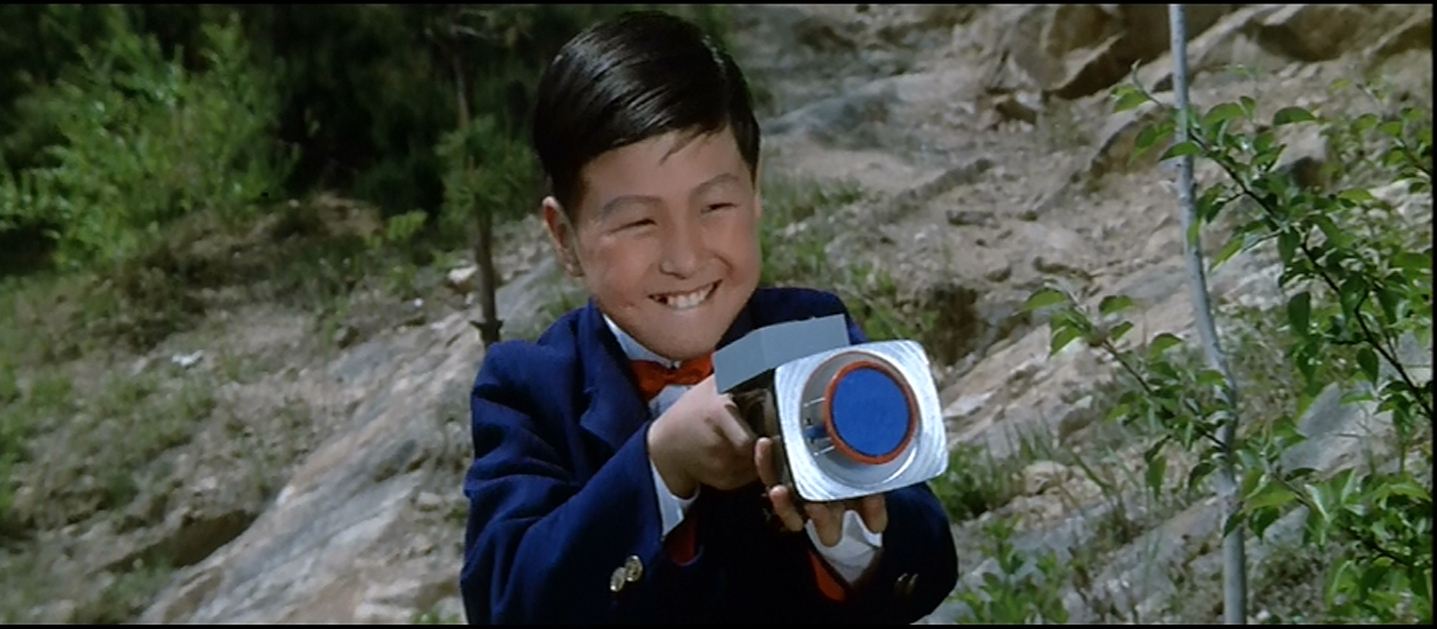
Yonggary is only sort of a nuclear monster. A nuclear detonation goes off... somewhere, and then an earthquake burrows its way to Seoul. Like many later films, Yonggary seems to be more about the threat of nuclear war than a protest of nuclear testing as was the original Godzilla. Which is certainly explicable; Korea was much more affected by the Cold War than by nuclear testing. It is notable, however, that the gigantic monster comes from far away and travels to Korea for no known reason. If Godzilla had a tenuous claim to being a symbol of American military might, Yonggary could also be read that way. But we never know whose nuclear weapon is dropped, and this is after China's initial nuclear tests, so this could be a projection of Korea's fears of Chinese nuclear aggression.
Yonggary itself first shows after twenty-six minutes, so we haven't been waiting around for long. Our first gimpse is his back, which bears a stubby triple fun pattern, likely borrowed from Godzilla. Overall, the suit is pretty good. The reticulated front pattern is a particularly nice touch. Unfortunately, and I don't know if this is a fault of the AIP translation or not, Yonggary has the same cry. Every time. It's a good cry, metallic and menacing, but it's the same damn one every time it opens its mouth. Further, they do not match the motions of Yonggary's mouth. The cry is drawn-out, but the mouth is always going, which makes Yonggary look like he's chewing gum.
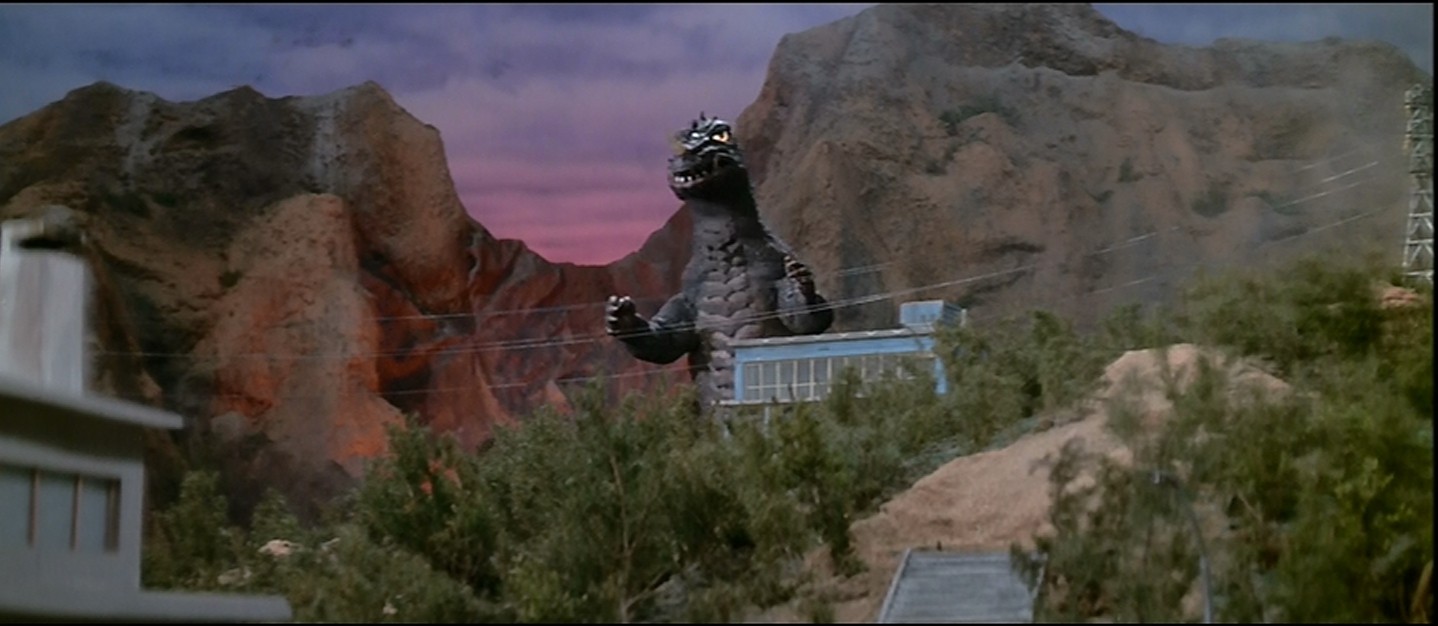
There are several common sequences in the film, panicked people running to escape the monster, the preacher glad that the end of days is finally here (a nice reference to Gorgo), the greedy businessmen feasting with nihilistic abandon, the kids dancing their cares away, the initial efforts of the military, the symbolic melting of the first tank.
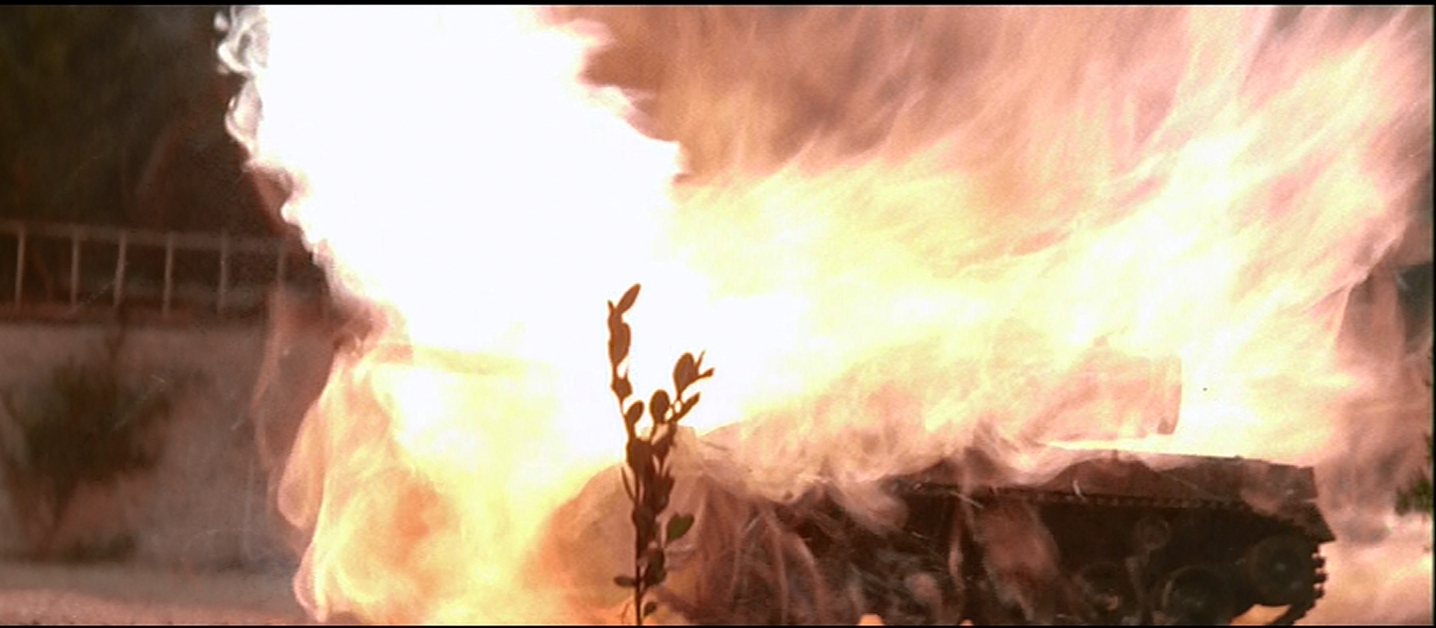
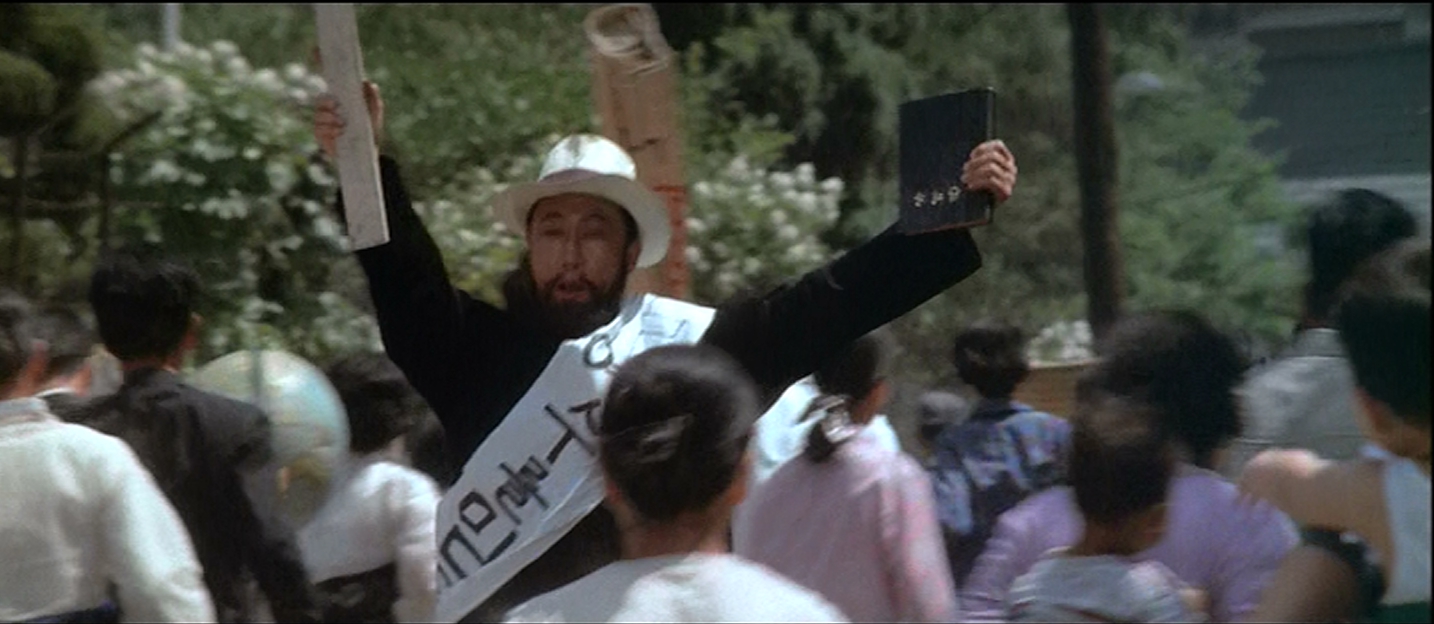
The rampage is witnessed by the adult protagonist (Ilo) and the kid (Icho), and Icho finds a novel way to experience the monster close at hand, by climbing down a manhole. Yonggary steps directly on the manhole, which gives a moment of tension, despite my dislike of the Icho character. It's a clever way to get Icho very close to Yonggary.
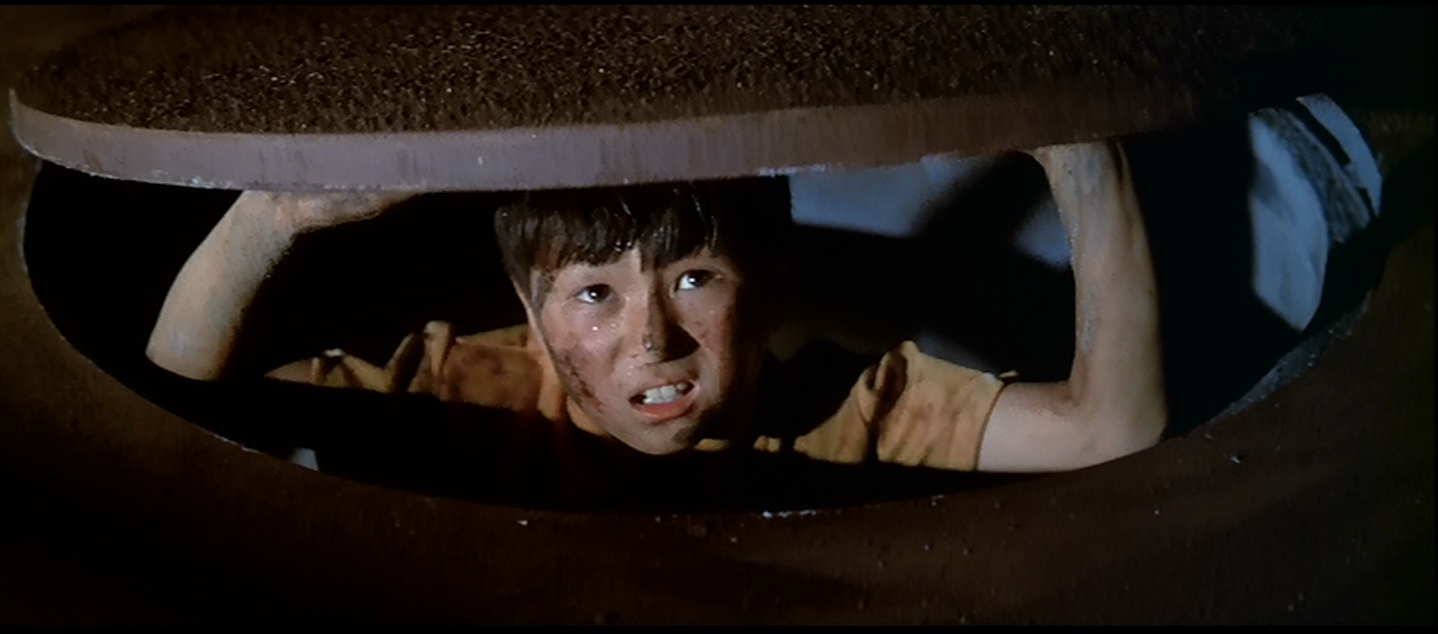
Yongarry can be distracted by helicopters that fly slowly, and so it is lead out of Seoul into a refinery where, in another tribute to Gamera, he sucks down a storage tank of oil. But when he destroys a container full of ammonia, he begins to itch at himself, providing Icho with the clue he needs to eventually destroy the monster. The Korean military then uses some experimental missiles on Yonggary, which of course doesn't work. But first, there's a strange interlude in which beach music plays and Yonggary dances. It's a really weird bit, possibly to give the monster more sympathy, because nothing makes the heart sing like a kid and giant monster dancing together.
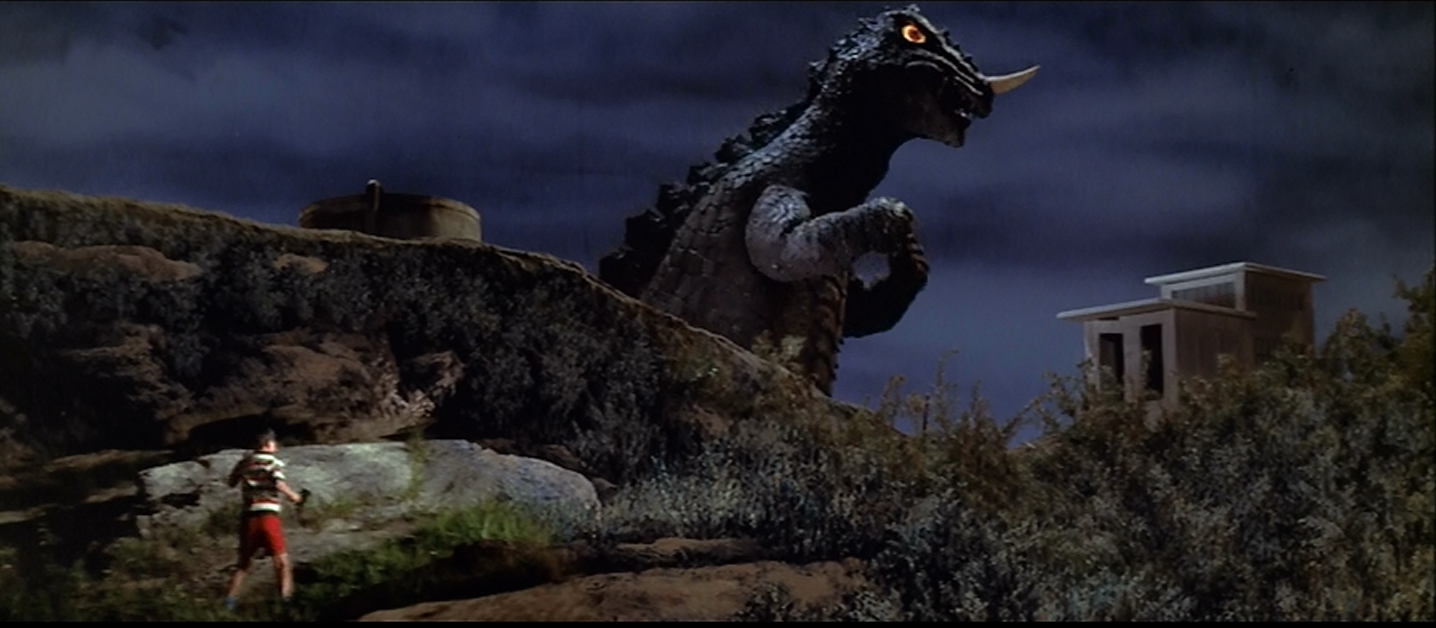
After which he really nails his debt to Gamera by using his nose horn beam to slice a jeep in half. Exactly the same trick (with the same problem--again, you can see the supporting wheel in the sliced-open Jeep) way that Gyaos did.
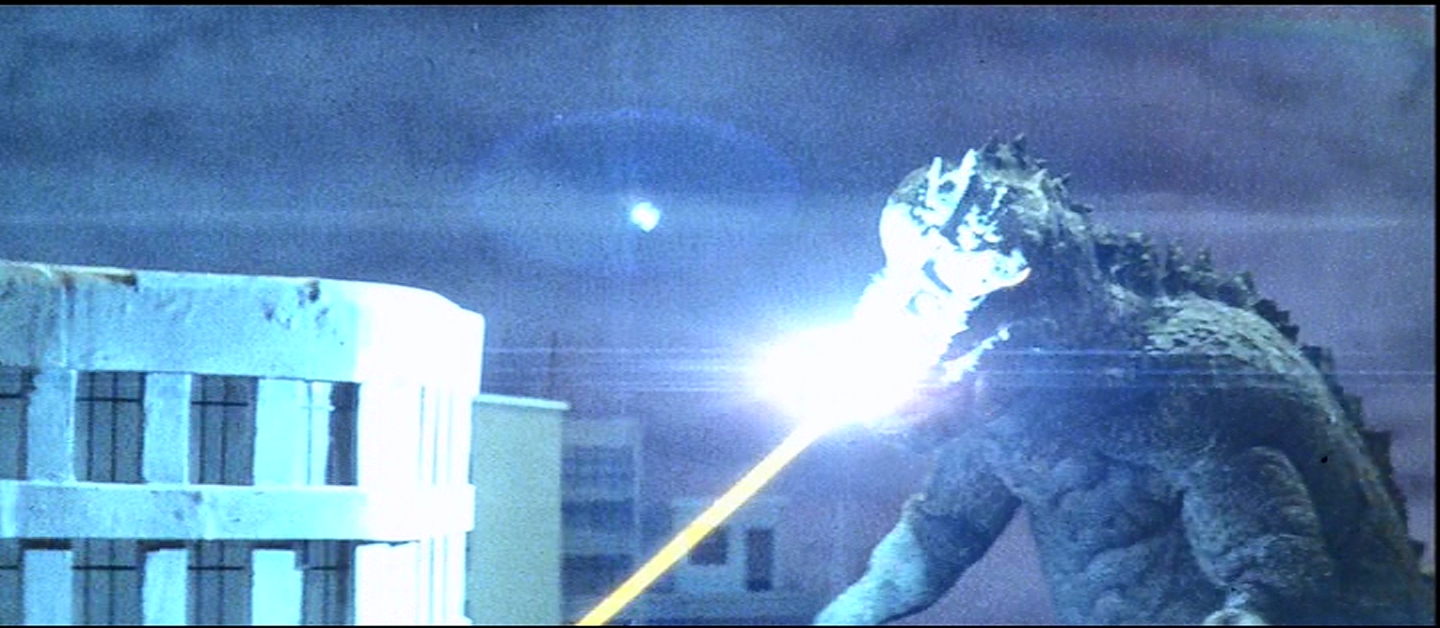
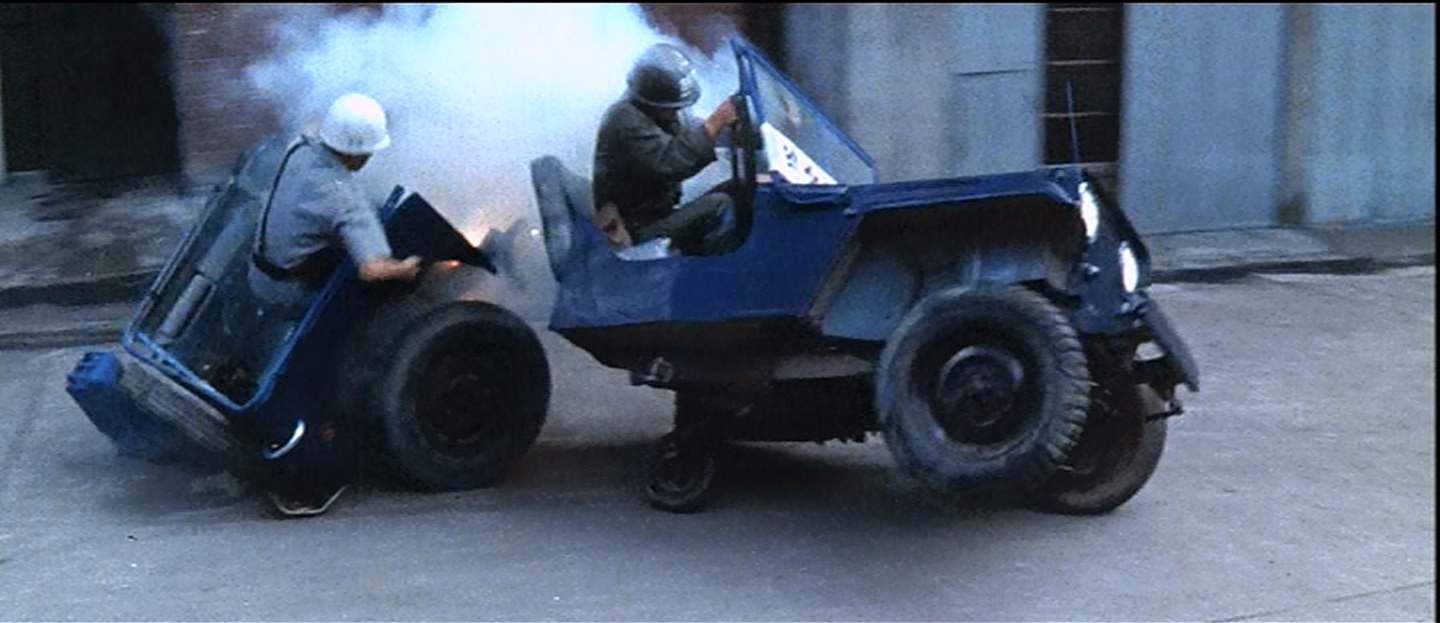
There's a moment, as planes attack, that the Yonggary suit catches fire, just below the left eye. This leaves a notable chunk of the rubber skin flapping around for the rest of the sequence. Probably a good thing they film the scenes with explosions last.
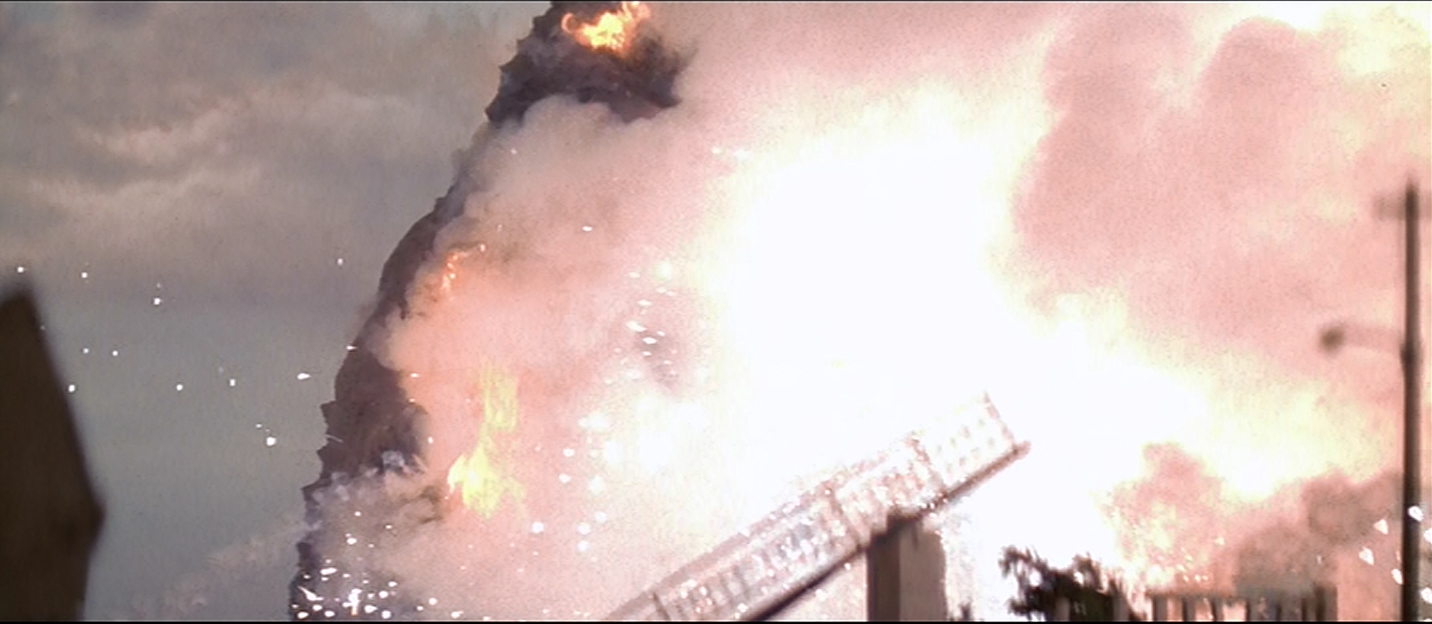
Further, as the polits retreat, Yonggary uses his nose horn to slice one of the Lockheed F-104 Starfighters in half. This might even be the same model that we saw Gyaos slice through.
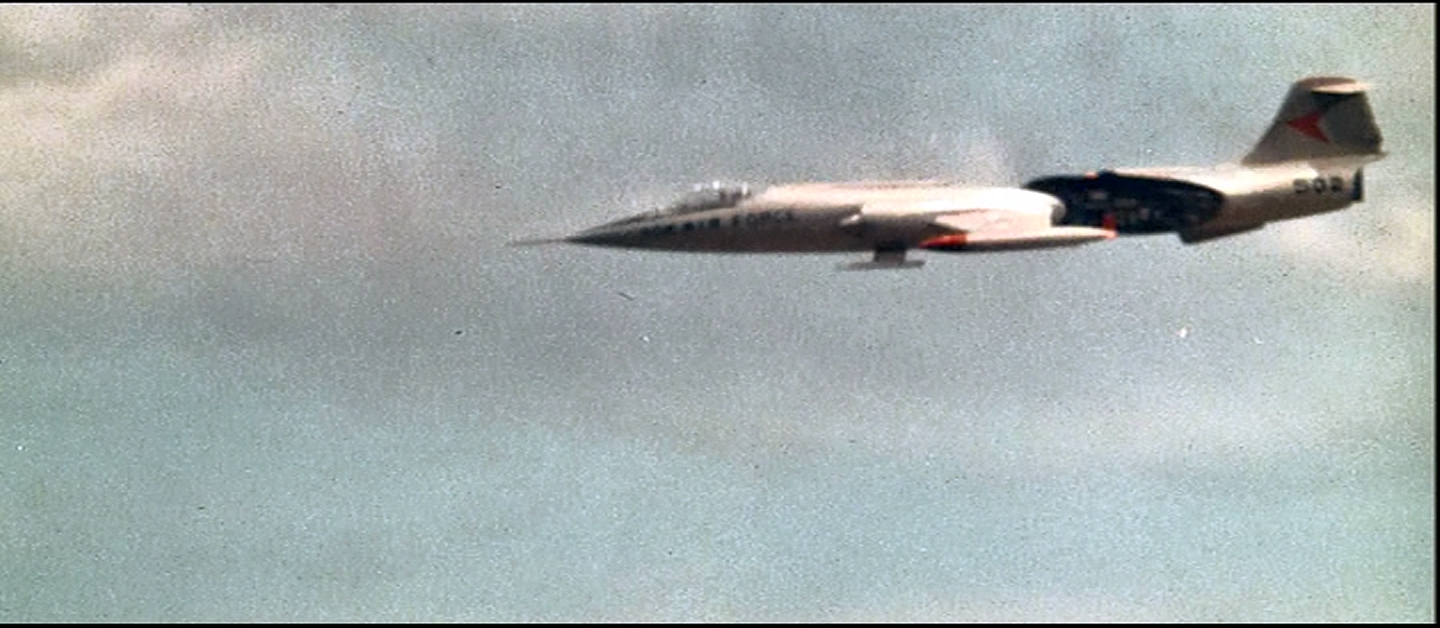
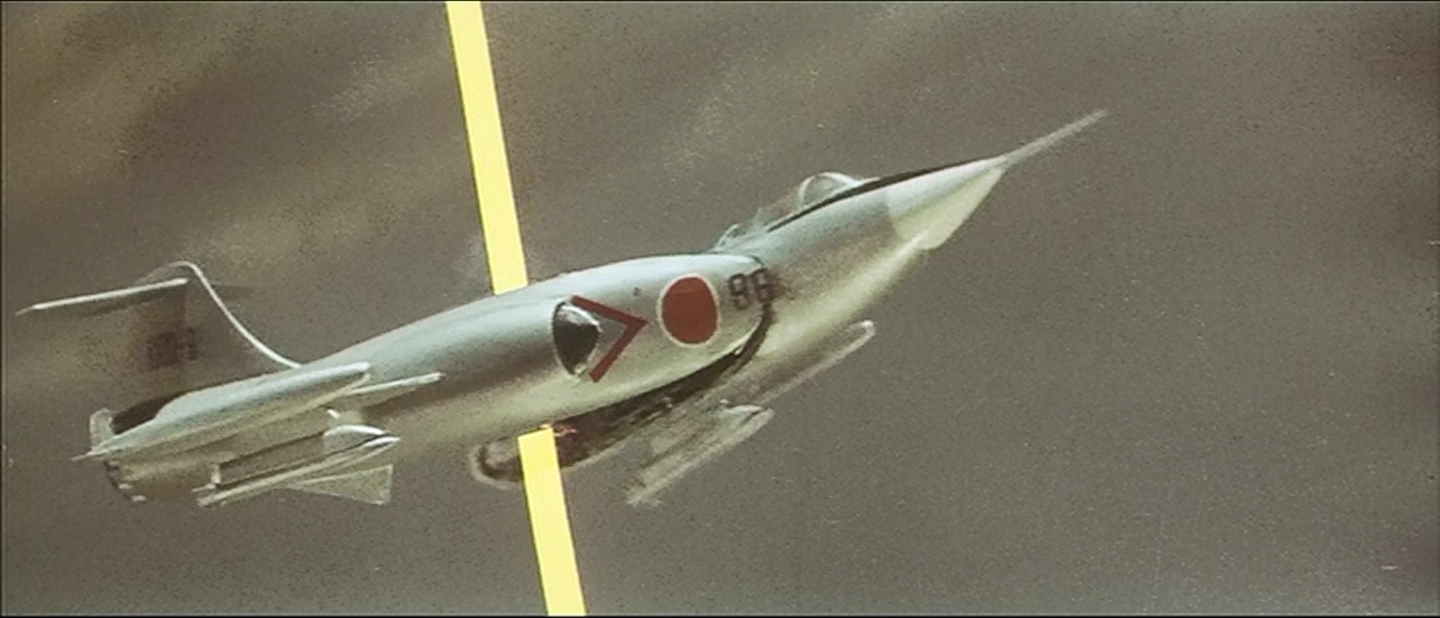
But the monster cannot be allowed to live. Ilo and Icho, in a helicopter, drop loads of ammonia on Yonggary, who collapses, twitches, and bleeds out in one of the more disturbing monster deaths. Of course, Ilo has his fiance up in the helicopter, and she's laughing about it. The film is surprisingly tone-deaf about its emotional tenor.
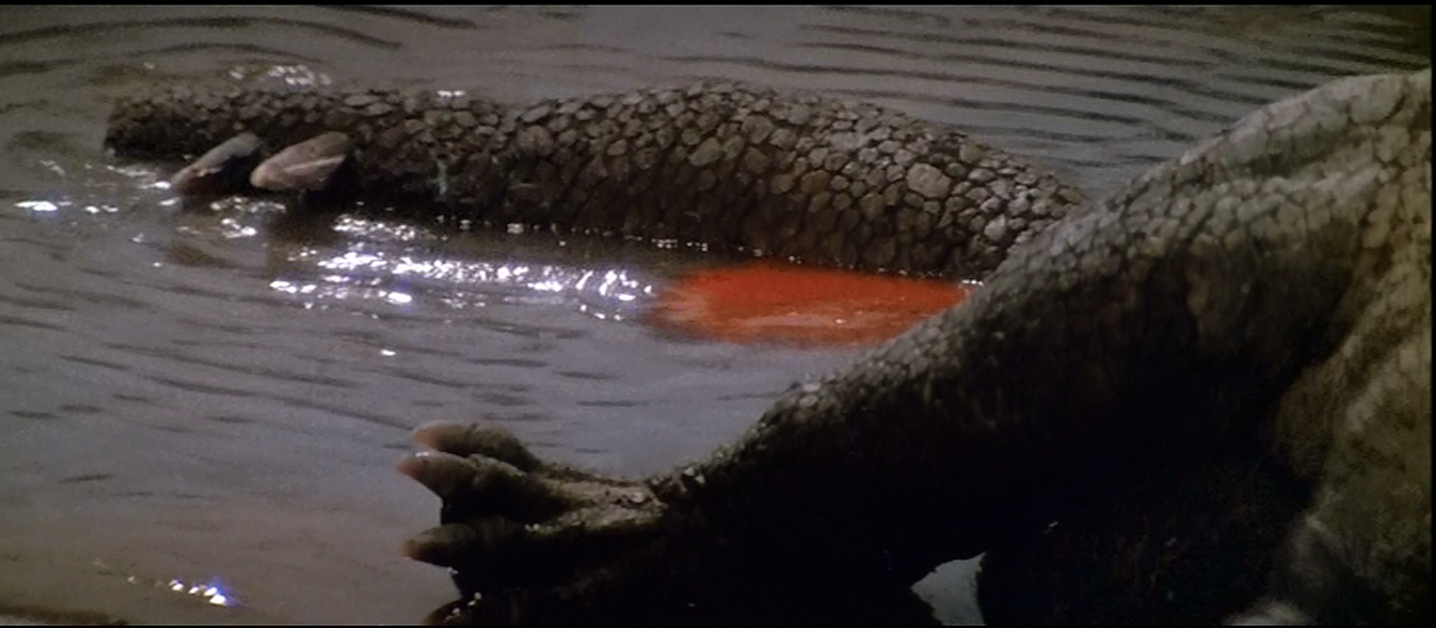
Despite my complaints, I do enjoy Yonggary. The monster effects are decent, and it's got a couple fresh ideas. The child is pretty annoying, but the long monster effects sequences make this easier to bear. As far as transfer goes, the MGM Mignight Movie version, a double sided disk with Konga, is definitely the best. Presented in widescreen, it's also notable less muddy than other versions I have owned.
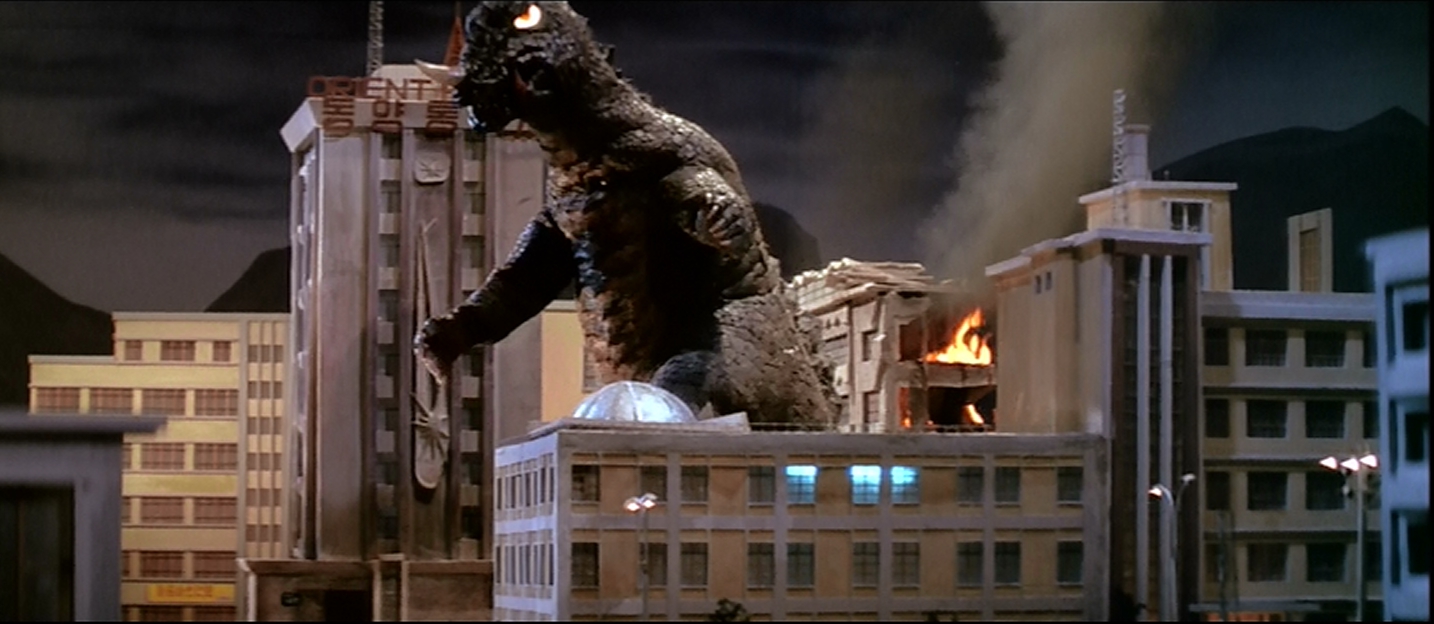
Yonggary was reimagined around the same time, and in the same spirit of Godzilla 1998. Which is to say it has almost nothing to do with the original film. A second edit was made for release to Western audiences, and the original Korean version is unavailable. We'l get to it in due time.
Next week, a monster whose name I can't pronounce, once again from a movie I haven't seen.

But early on, the film feels a lot like Giant Space Monster Guilala or Invasion of Astro-Monster, because South Korea has a manned space program. This is, oddly, a deal breaker for some reviewers, who consider it ridiculous. But a film-maker from a country that had no space program in the 60's really didn't have much choice. Either they could make everyone involved in the program American or Russian, but where were they going to find that many American or Russian actors, and why would they all be speaking Korean or Japanese? But beyond that, kaiju films are a mix of science fiction and fantasy, and why shouldn't a country which is proud of its achievements, dream that one day they will also reach for the stars?

Unfortunately, the Korean cut of this film has been lost. All that I can access is the AIP dub of the film. And I feel that dubs tend to water down the acting abilities of the cast, making them less sympathetic.
Early in the film, we discover that Icho is a protagonist. He's a precocious kid, who has developed an ithcing ray that he inflicts on a pair of newlyweds. Ho ho, what a great character! We'll be seeing a lot of him.

Yonggary is only sort of a nuclear monster. A nuclear detonation goes off... somewhere, and then an earthquake burrows its way to Seoul. Like many later films, Yonggary seems to be more about the threat of nuclear war than a protest of nuclear testing as was the original Godzilla. Which is certainly explicable; Korea was much more affected by the Cold War than by nuclear testing. It is notable, however, that the gigantic monster comes from far away and travels to Korea for no known reason. If Godzilla had a tenuous claim to being a symbol of American military might, Yonggary could also be read that way. But we never know whose nuclear weapon is dropped, and this is after China's initial nuclear tests, so this could be a projection of Korea's fears of Chinese nuclear aggression.
Yonggary itself first shows after twenty-six minutes, so we haven't been waiting around for long. Our first gimpse is his back, which bears a stubby triple fun pattern, likely borrowed from Godzilla. Overall, the suit is pretty good. The reticulated front pattern is a particularly nice touch. Unfortunately, and I don't know if this is a fault of the AIP translation or not, Yonggary has the same cry. Every time. It's a good cry, metallic and menacing, but it's the same damn one every time it opens its mouth. Further, they do not match the motions of Yonggary's mouth. The cry is drawn-out, but the mouth is always going, which makes Yonggary look like he's chewing gum.

There are several common sequences in the film, panicked people running to escape the monster, the preacher glad that the end of days is finally here (a nice reference to Gorgo), the greedy businessmen feasting with nihilistic abandon, the kids dancing their cares away, the initial efforts of the military, the symbolic melting of the first tank.


The rampage is witnessed by the adult protagonist (Ilo) and the kid (Icho), and Icho finds a novel way to experience the monster close at hand, by climbing down a manhole. Yonggary steps directly on the manhole, which gives a moment of tension, despite my dislike of the Icho character. It's a clever way to get Icho very close to Yonggary.

Yongarry can be distracted by helicopters that fly slowly, and so it is lead out of Seoul into a refinery where, in another tribute to Gamera, he sucks down a storage tank of oil. But when he destroys a container full of ammonia, he begins to itch at himself, providing Icho with the clue he needs to eventually destroy the monster. The Korean military then uses some experimental missiles on Yonggary, which of course doesn't work. But first, there's a strange interlude in which beach music plays and Yonggary dances. It's a really weird bit, possibly to give the monster more sympathy, because nothing makes the heart sing like a kid and giant monster dancing together.

After which he really nails his debt to Gamera by using his nose horn beam to slice a jeep in half. Exactly the same trick (with the same problem--again, you can see the supporting wheel in the sliced-open Jeep) way that Gyaos did.


There's a moment, as planes attack, that the Yonggary suit catches fire, just below the left eye. This leaves a notable chunk of the rubber skin flapping around for the rest of the sequence. Probably a good thing they film the scenes with explosions last.

Further, as the polits retreat, Yonggary uses his nose horn to slice one of the Lockheed F-104 Starfighters in half. This might even be the same model that we saw Gyaos slice through.


But the monster cannot be allowed to live. Ilo and Icho, in a helicopter, drop loads of ammonia on Yonggary, who collapses, twitches, and bleeds out in one of the more disturbing monster deaths. Of course, Ilo has his fiance up in the helicopter, and she's laughing about it. The film is surprisingly tone-deaf about its emotional tenor.

Despite my complaints, I do enjoy Yonggary. The monster effects are decent, and it's got a couple fresh ideas. The child is pretty annoying, but the long monster effects sequences make this easier to bear. As far as transfer goes, the MGM Mignight Movie version, a double sided disk with Konga, is definitely the best. Presented in widescreen, it's also notable less muddy than other versions I have owned.

Yonggary was reimagined around the same time, and in the same spirit of Godzilla 1998. Which is to say it has almost nothing to do with the original film. A second edit was made for release to Western audiences, and the original Korean version is unavailable. We'l get to it in due time.
Next week, a monster whose name I can't pronounce, once again from a movie I haven't seen.
Thursday, December 5, 2013
Because Kaiju Have Feelings, Too: Gappa the Triphidian Monsters
Nikkatsu is the final Japanese studio to participate in the Giant Monster Explosion of 1967. Their offering, Daikyojû Gappa was a staple of afternoon monster fests in the seventies and eighties. Gappa is, like most first studio offerings, a mishmash of ideas from previous films.
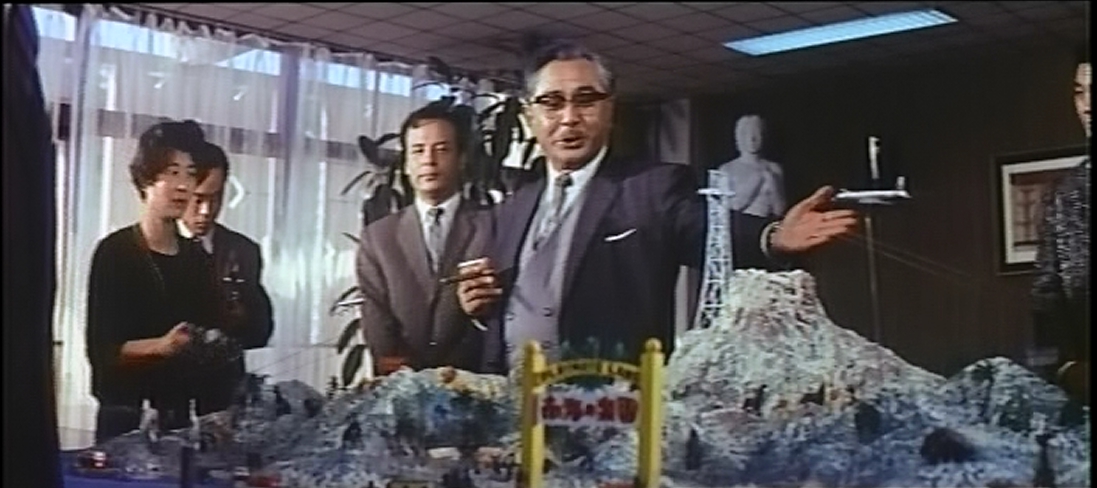
As with Godzilla vs Mothra, the motivator for the plot of the greedy industrialist, in this case the publisher of Playmate magazine. He's bought the island outright, so the indigenous people are going to have to move. The irony is that Nikkatsu was converting itself to producer of soft-core "pink" films.
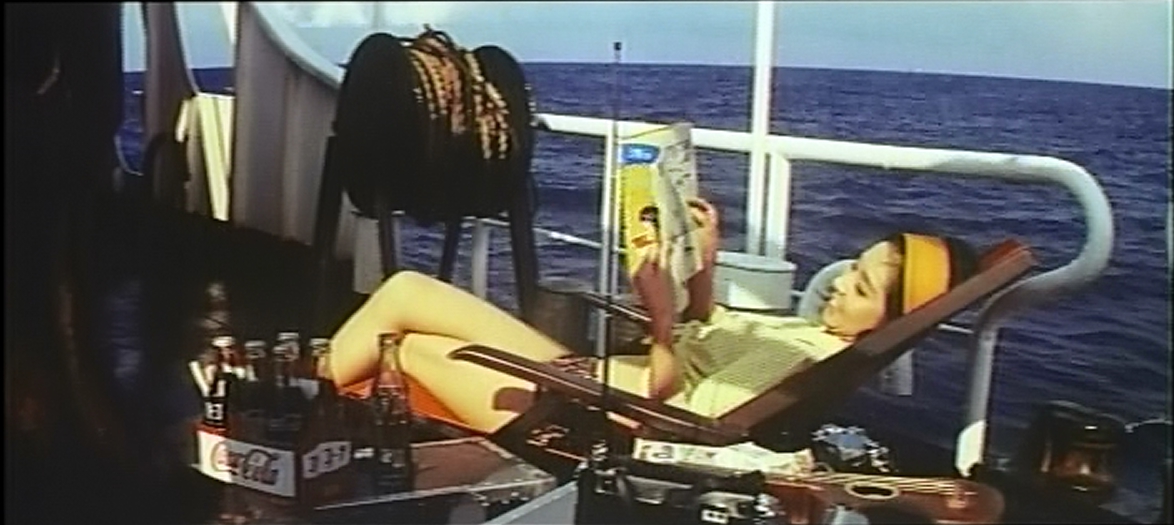
Gappa is the god of Obelisk Island (which joins the archipelago of monster-infested locations such as Odo Island, Infant Island, Devil's Island and Sollgel Island. Nara Island is, of course, in the Atlantic). But the Pacific is large, and jamming one more island in there won't really be noticeable. The natives could have stepped out of either King Kong vs Godzilla or Gamera vs Barugon. The women dance with spears and shields while the men wear breechclots in tartan and other patterns.
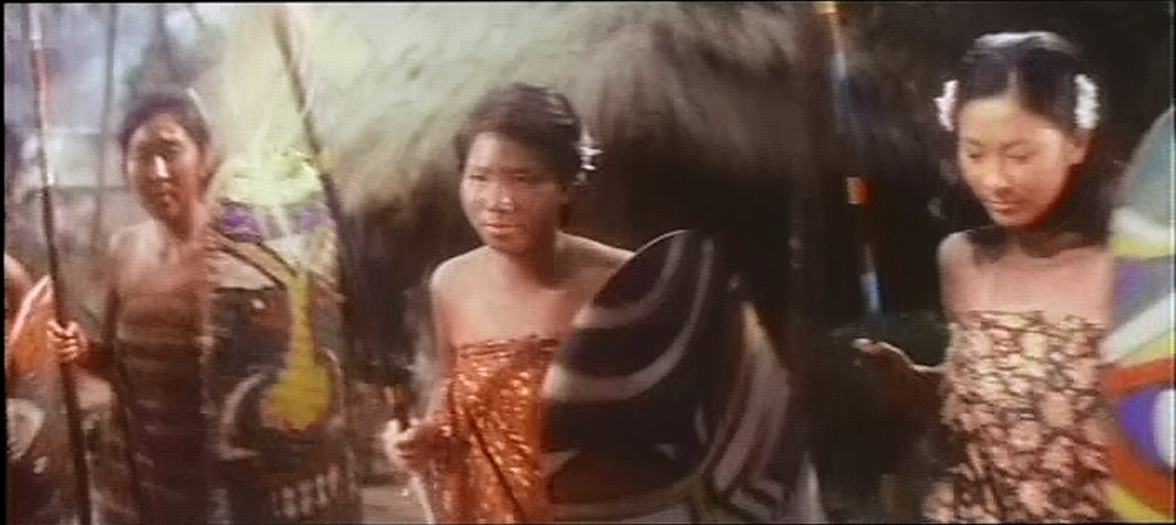
The story itself is well-cribbed from Gorgo. The explorers come to Obelisk Island and capture the immature Gappa. The greedy industrialist intends to put it on display, but this plan is interrupted by the arrival of the parents.
Gappa also includes the era-obligatory child protagonist, Saki here. While not nearly as annoying as many of the Gamera kids, he's in the mould of Sean. He's the connection to the island culture, and the one person, in addition to the only women on the expedition, Itoko, who feels any sympathy for the baby Gappa before its parents begin stomping the city.
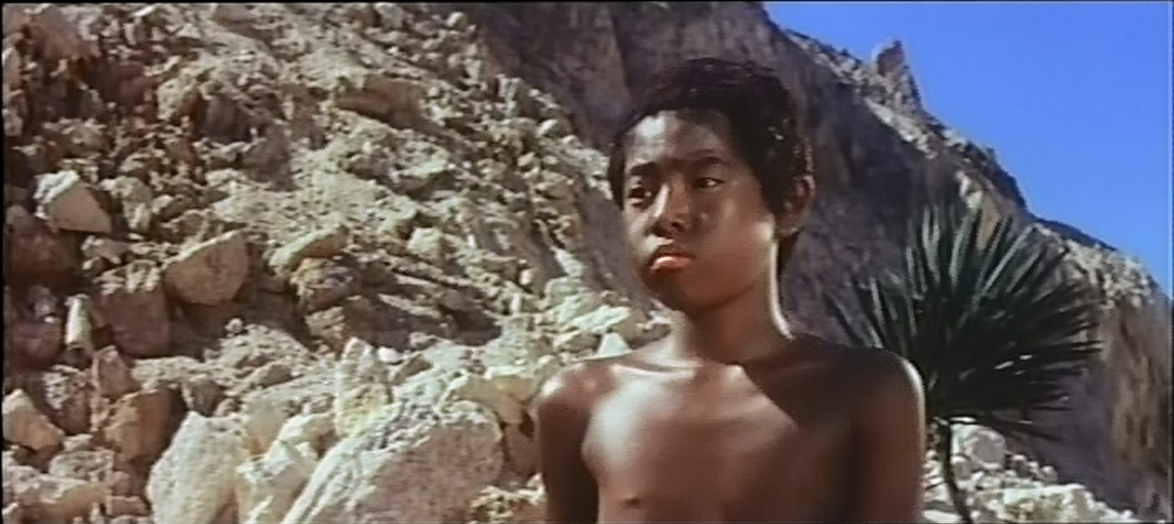
Baby Gappa isn't actually put on display, as it was in Gorgo. Instead, there's some medical experimentation, including making it wear some very strange headgear, to measure the brain waves. This again echoes Gorgo, as well as Minilla, and is a template for the discovery of Godzilla, Jr, from the Heisei series' 1993 Godzilla vs Mechagodzilla.
.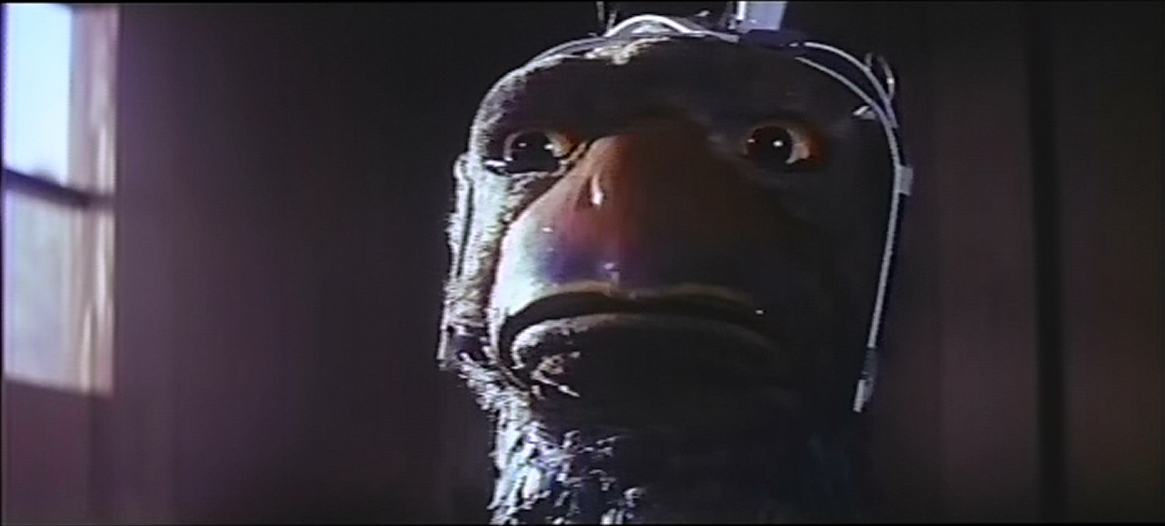
The suits are pretty good. Effects director Akira Watanabe, who worked with Eiji Tsuburaya on Godzilla and and dozen other kaiju films, created the Gappa costumes out of latex, rather than the cloth-based costimes from Daiei. He made some very thoughtful choices. The adult Gappa display sexual dimorphism, the crests on the male and female creatures are different. When the Gappa first appear, one of them is carrying a large octopus in its mouth, which I assume is to feed the baby Gappa. So despite feeling like it was assembled out of ideas from other films, Gappa has a certain amount of originality, and a bit more depth than many films of the period. Which is why I find Gappa, despite the B-plot elements, to be watchable.
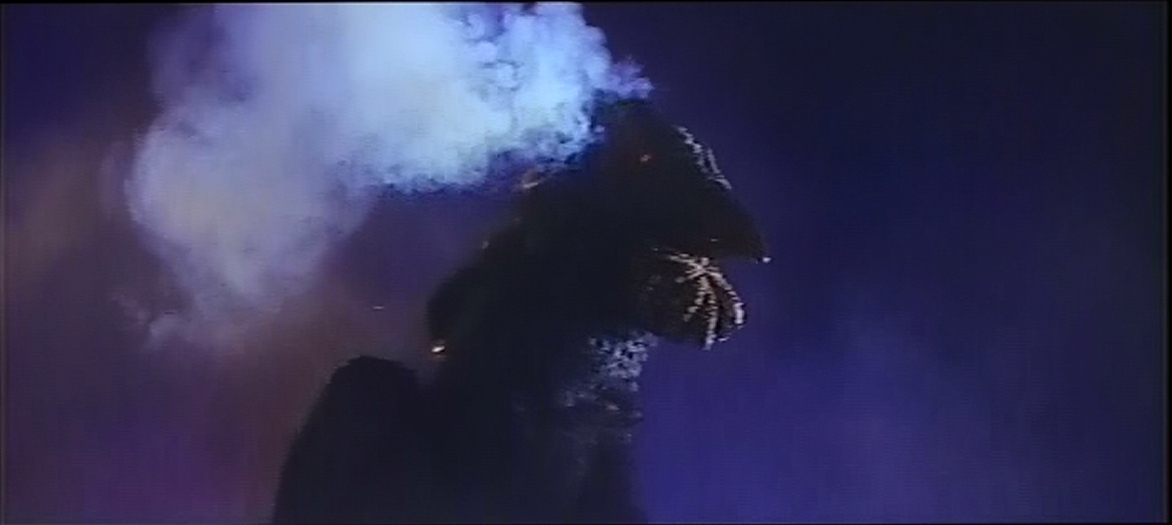
Like Godzilla, the Gappa have some sort of breath weapon, and they uleash it on tanks, first. Like Gorgo, the Gappa are not nuclear mutants. More like Mothra, they are unappeased gods on their own islands. Very little is explained in the film, where they came from, what their breath weapons actually are. But by this time, the monster film audience had likely seen enough monster films thast an explanation was unnecessary. Monsters have some sort of breath weapon.
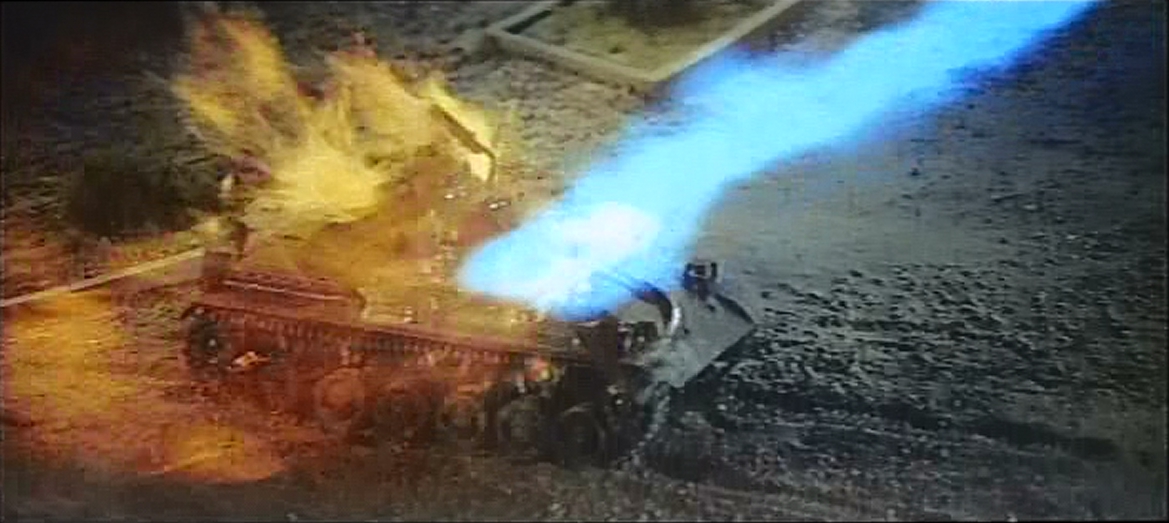
The Gappa combine the size and heat ray of Godzilla with the flight of Rodan, making them very difficult to pin down. They also can breathe underwater, which is what inspired the "triphidian" title from the American DVD release. They hide in a lake while Playmate is selling a crapload of copies, even as the publisher holds the baby Gappa and denies responsibility for the Gappas' rampage. The humans are not sympathetic in this film; the monsters are.
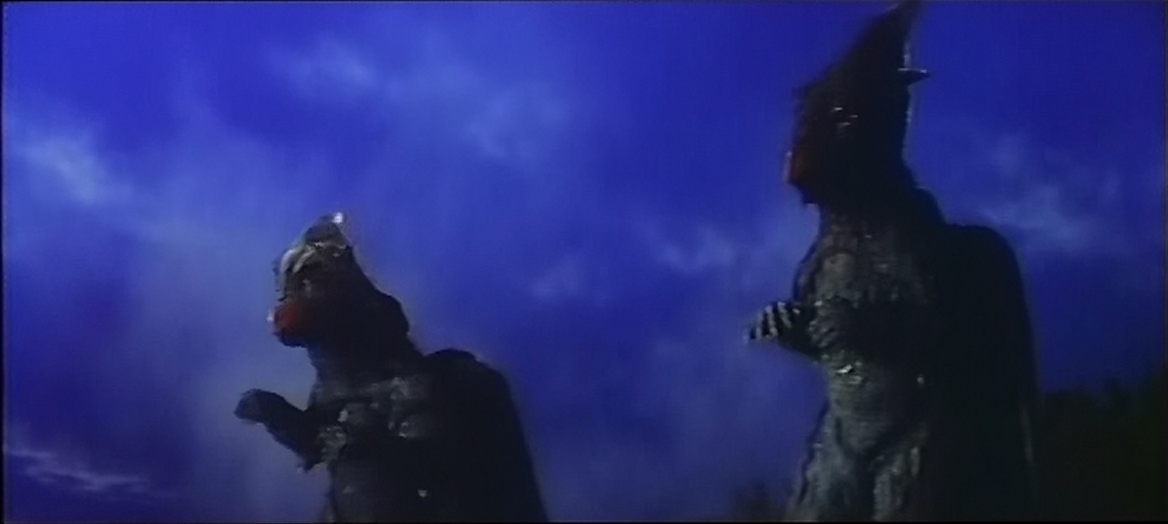
After a bit of stomping the Gappa retire to a lake within sight of Mt. Fuji. The military decide to dislodge the Gappa with high-frequency sound and launch missiles at them when they emerge. While the idea is good, the execution is rather strange. They send boats out into the lake, and then sink them to bring the sound below the surface. I suppose an underwater speaker would have done, but the boats look pretty cool as they sink into the water. It succeeds, and the Gappa come out, ignore the missile surprise waiting for them, and head straight for long-suffering Tokyo.
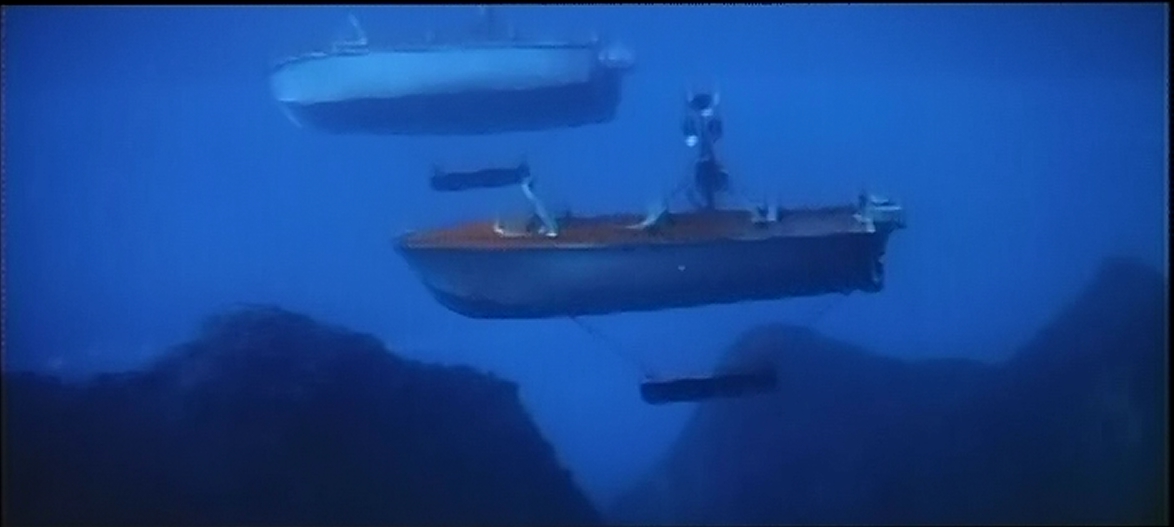
In an attempt to forestall the destruction, baby Gappa is flown to the Tokyo airport in a helicopter and balloon contraption that looks a bit like a modified Kong-moving rig from King Kong vs Godzilla.
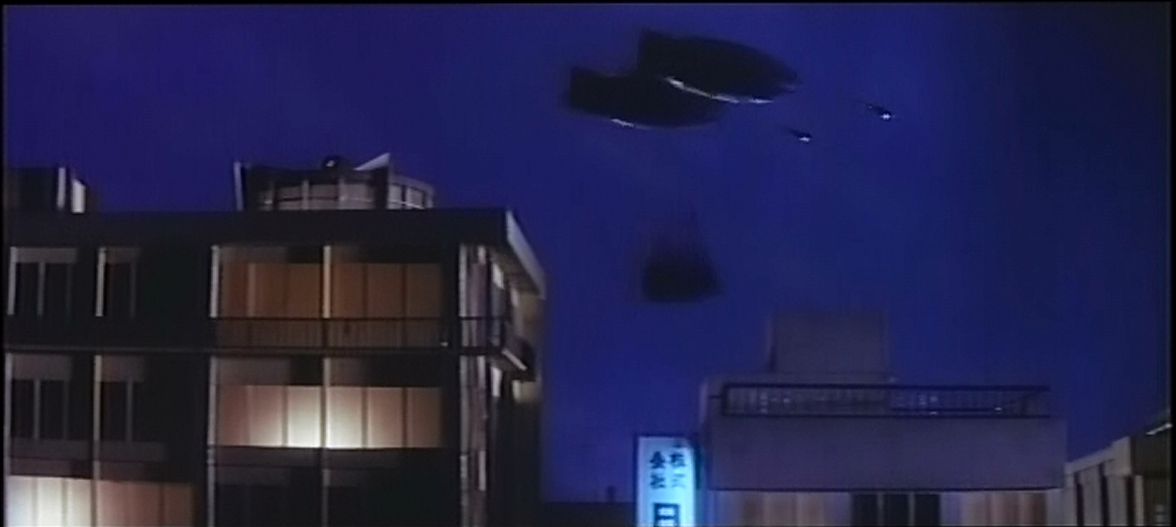
At the airport, the monster family is reunited, and manages to do so in a way that is sweet, without being nauseating. Taking its cute from Gorgo, Gappa aims at children but doesn't pander to them, leaving us with a watchable film that doesn't treat us as if we were intellectually and emotionally stunted. Until the moment that they ruin it by having the token woman decide that she wants to give up her career and have babies. In keeping with the theme of the importance of family, I suppose, but a little hard to take forty-five years later.
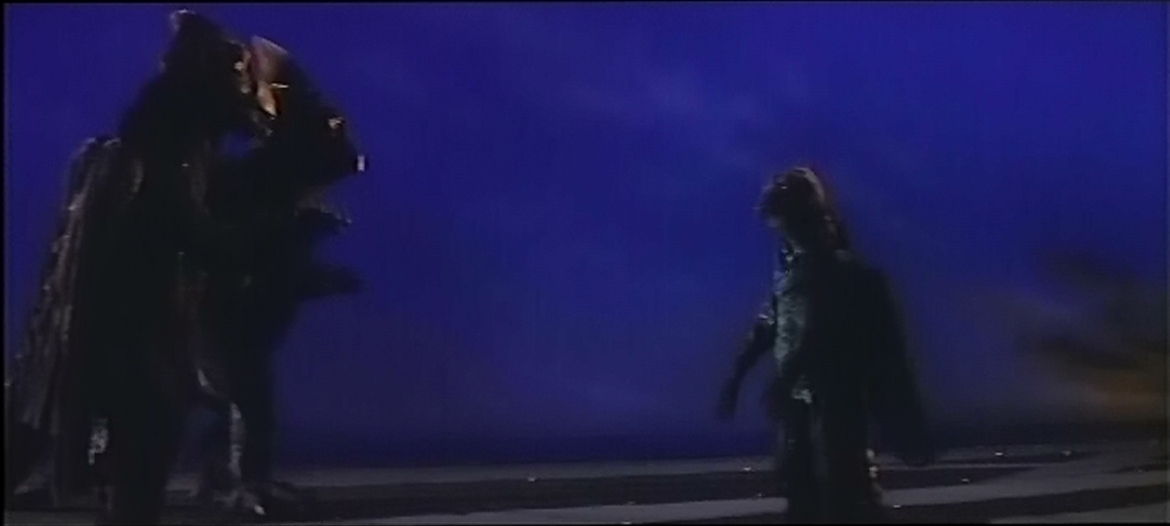
Overall, Gappa is a pretty good giant monster film. It moves along at a decent clip, the kid doesn't get a lot of screen time, and the human subplot is inoffensive (except that last bit). I've watched this more times than any of the Gamera films, and more than several Godzilla films. These pictures were taken from the Tokyo Shock version, which isn't a fantastic transfer, but for the subbed version, this is the only option. The monster sequences are dark, and they have significant more scratching than the non special effects sections. I hope that with the success of Pacific Rim and the anticipated success of Godzilla 2014, we'll be able to get several of the more obscure films onto a good transfer, whether on DVD or Blu-Ray.
Next, we move out of Japan, but not out of Asia. The overly-familiar Yonggary, next week on My Week of Monsters.

As with Godzilla vs Mothra, the motivator for the plot of the greedy industrialist, in this case the publisher of Playmate magazine. He's bought the island outright, so the indigenous people are going to have to move. The irony is that Nikkatsu was converting itself to producer of soft-core "pink" films.

Gappa is the god of Obelisk Island (which joins the archipelago of monster-infested locations such as Odo Island, Infant Island, Devil's Island and Sollgel Island. Nara Island is, of course, in the Atlantic). But the Pacific is large, and jamming one more island in there won't really be noticeable. The natives could have stepped out of either King Kong vs Godzilla or Gamera vs Barugon. The women dance with spears and shields while the men wear breechclots in tartan and other patterns.

The story itself is well-cribbed from Gorgo. The explorers come to Obelisk Island and capture the immature Gappa. The greedy industrialist intends to put it on display, but this plan is interrupted by the arrival of the parents.
Gappa also includes the era-obligatory child protagonist, Saki here. While not nearly as annoying as many of the Gamera kids, he's in the mould of Sean. He's the connection to the island culture, and the one person, in addition to the only women on the expedition, Itoko, who feels any sympathy for the baby Gappa before its parents begin stomping the city.

Baby Gappa isn't actually put on display, as it was in Gorgo. Instead, there's some medical experimentation, including making it wear some very strange headgear, to measure the brain waves. This again echoes Gorgo, as well as Minilla, and is a template for the discovery of Godzilla, Jr, from the Heisei series' 1993 Godzilla vs Mechagodzilla.
.

The suits are pretty good. Effects director Akira Watanabe, who worked with Eiji Tsuburaya on Godzilla and and dozen other kaiju films, created the Gappa costumes out of latex, rather than the cloth-based costimes from Daiei. He made some very thoughtful choices. The adult Gappa display sexual dimorphism, the crests on the male and female creatures are different. When the Gappa first appear, one of them is carrying a large octopus in its mouth, which I assume is to feed the baby Gappa. So despite feeling like it was assembled out of ideas from other films, Gappa has a certain amount of originality, and a bit more depth than many films of the period. Which is why I find Gappa, despite the B-plot elements, to be watchable.

Like Godzilla, the Gappa have some sort of breath weapon, and they uleash it on tanks, first. Like Gorgo, the Gappa are not nuclear mutants. More like Mothra, they are unappeased gods on their own islands. Very little is explained in the film, where they came from, what their breath weapons actually are. But by this time, the monster film audience had likely seen enough monster films thast an explanation was unnecessary. Monsters have some sort of breath weapon.

The Gappa combine the size and heat ray of Godzilla with the flight of Rodan, making them very difficult to pin down. They also can breathe underwater, which is what inspired the "triphidian" title from the American DVD release. They hide in a lake while Playmate is selling a crapload of copies, even as the publisher holds the baby Gappa and denies responsibility for the Gappas' rampage. The humans are not sympathetic in this film; the monsters are.

After a bit of stomping the Gappa retire to a lake within sight of Mt. Fuji. The military decide to dislodge the Gappa with high-frequency sound and launch missiles at them when they emerge. While the idea is good, the execution is rather strange. They send boats out into the lake, and then sink them to bring the sound below the surface. I suppose an underwater speaker would have done, but the boats look pretty cool as they sink into the water. It succeeds, and the Gappa come out, ignore the missile surprise waiting for them, and head straight for long-suffering Tokyo.

In an attempt to forestall the destruction, baby Gappa is flown to the Tokyo airport in a helicopter and balloon contraption that looks a bit like a modified Kong-moving rig from King Kong vs Godzilla.

At the airport, the monster family is reunited, and manages to do so in a way that is sweet, without being nauseating. Taking its cute from Gorgo, Gappa aims at children but doesn't pander to them, leaving us with a watchable film that doesn't treat us as if we were intellectually and emotionally stunted. Until the moment that they ruin it by having the token woman decide that she wants to give up her career and have babies. In keeping with the theme of the importance of family, I suppose, but a little hard to take forty-five years later.

Overall, Gappa is a pretty good giant monster film. It moves along at a decent clip, the kid doesn't get a lot of screen time, and the human subplot is inoffensive (except that last bit). I've watched this more times than any of the Gamera films, and more than several Godzilla films. These pictures were taken from the Tokyo Shock version, which isn't a fantastic transfer, but for the subbed version, this is the only option. The monster sequences are dark, and they have significant more scratching than the non special effects sections. I hope that with the success of Pacific Rim and the anticipated success of Godzilla 2014, we'll be able to get several of the more obscure films onto a good transfer, whether on DVD or Blu-Ray.
Next, we move out of Japan, but not out of Asia. The overly-familiar Yonggary, next week on My Week of Monsters.
Thursday, November 28, 2013
That's One Hell of a Turkey: Giant Space Monster Guilala
Part of the reason I am writing My Year of Monsters is to watch the development of the visual language of kaiju film. Not just for its own sake, but as a microcosm of film in general, to see what elements are retained from film to film, what works, and what is discarded. I am not enough of a scholar of Japenese history to meaningfully comment on the social changes happening in Japan, or even America, as these films were procuced, to give an informed opinion about their sociocultural significance. But in learning the language of the film, we can draw conclusions about what makes a good kaiju film, and what makes one worth watching.
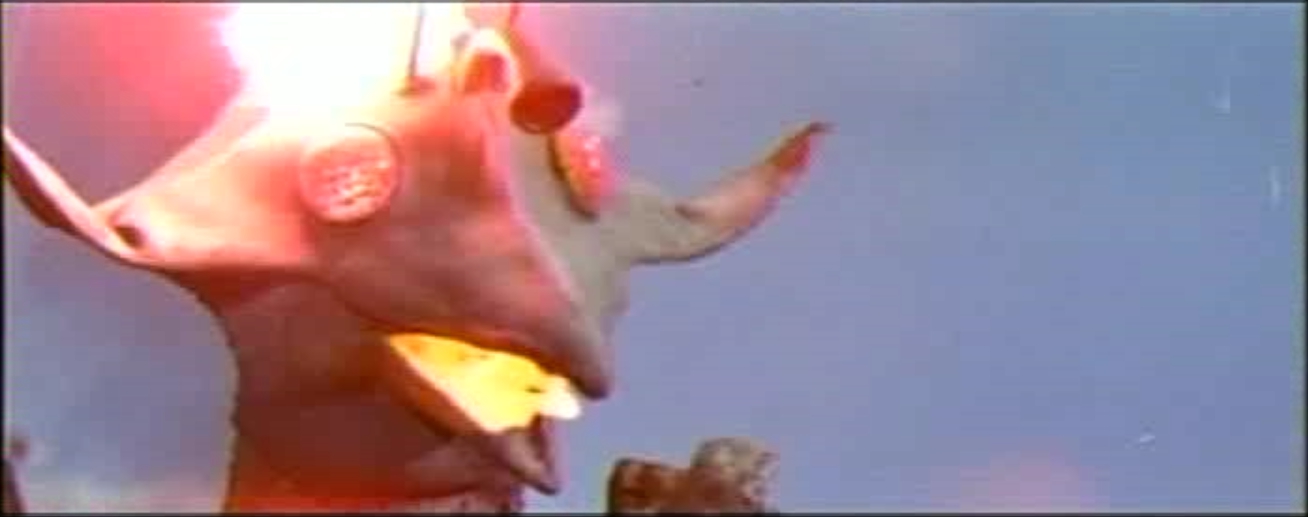
Released in the US as The X From Outer Space, Giant Space Monster Guilala (1967) is the only giant monster film from Japanese film studio Shochiku. It starts off with a lounge-act song over the initial credits. Which is a heck of a thing, especially as the film exhorts the listener to embrace the twinkling future. Given that this is a giant monster film, I cannot help but think that this is somewhat at odds with the embrace of future technology, since many kaiju films are about humanity being punished for scientific transgressions.
For the first time since the 1965 Gamera, this is a rampage movie. As with virtually every other franchise, thism, the first film, has the monster alone against the military and the team of scientists. Guilala does return, in 2009, with Monster X Strikes Back.
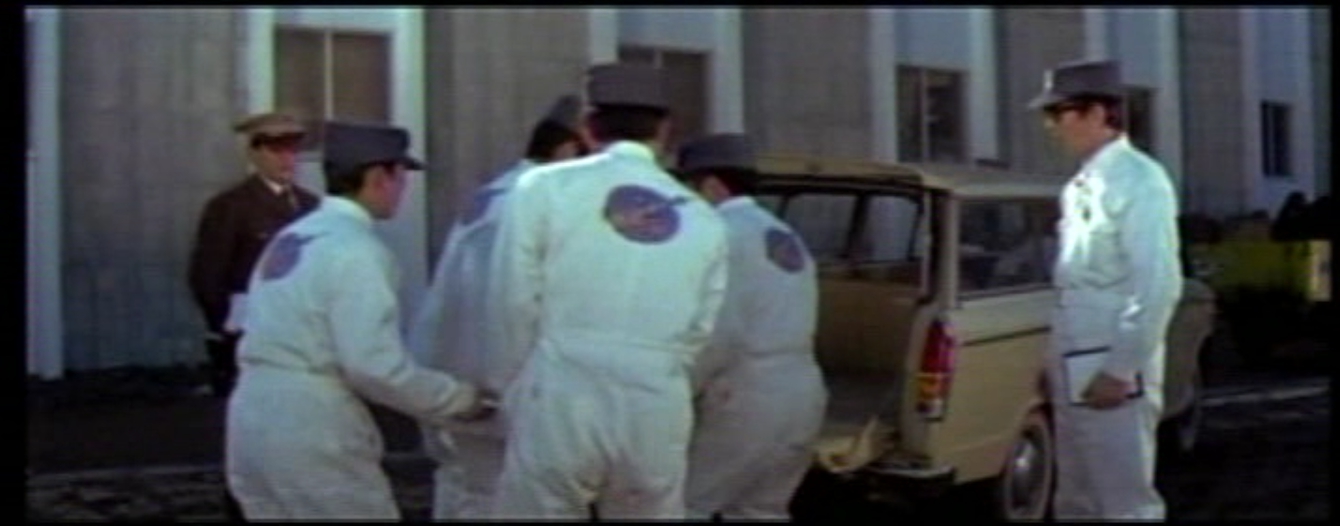
The film follows the Fuji Aeronautical Flight Center, the sort of agency that cropped up with regularity in space-race era films. Our first experience is watching four white jumpsuited figures carry enriched nuclear fuel and put it in the back of a station wagon. If that's not space-age professionalism, I don't know what is. This space agency is launching missions to Mars, and anticipating the Galactic Ghoul of the 90's, has long a number of missions previously. Of course, the lost missions were all manned, and the spaceship they're sending, AAB Gamma the agency's first nuclear ship, is unarmed. What could possibly go wrong?
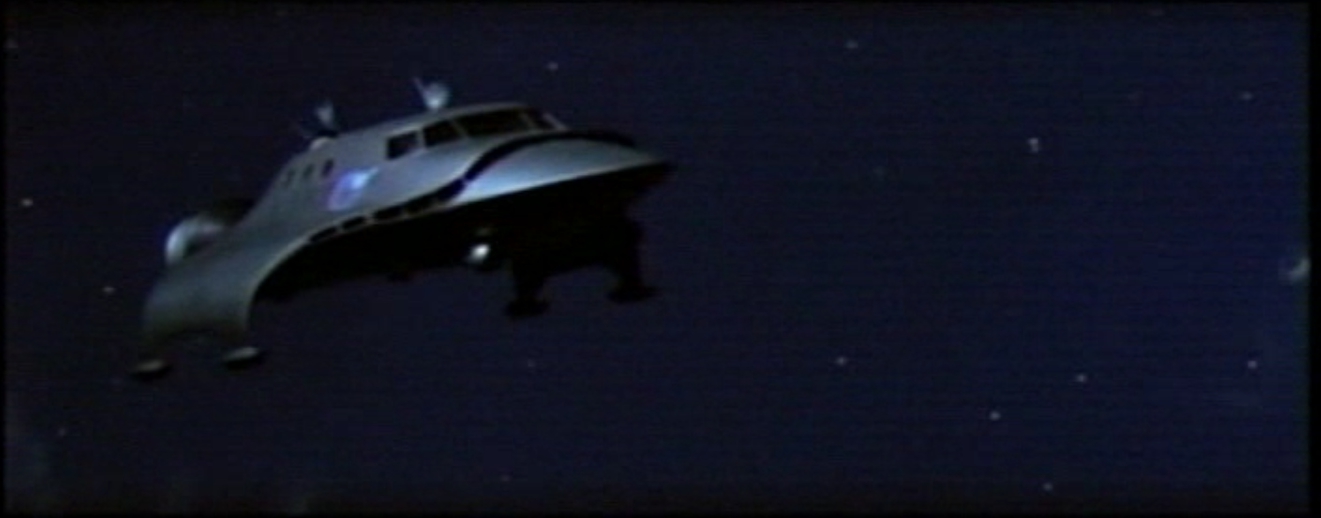
The anticipated problem, UFO interferance, happens, and the ship has to divert to the lunar base because Dr. Shioda has gotten ill from the UFO's approach. And who has to tend his fevered brow and brng him a drink? Why Lisa, the blonde, and the only woman on the crew. Huh. Blonde Lisa is also involved in a love traigle with the Sano, captain of AAB Gamma, who thinks he likes her, but really belongs with Michiko. Despite this early, dismissive treatment, the character of Lisa has a lot of agency, and that's a welcome relief from most kaiju films, which shove the female characters into stereotypical and passive roles. In fact, she is the discoverer of just about all the research that defeats Guilala will come from her. But she starts out as a Space Stewartess.
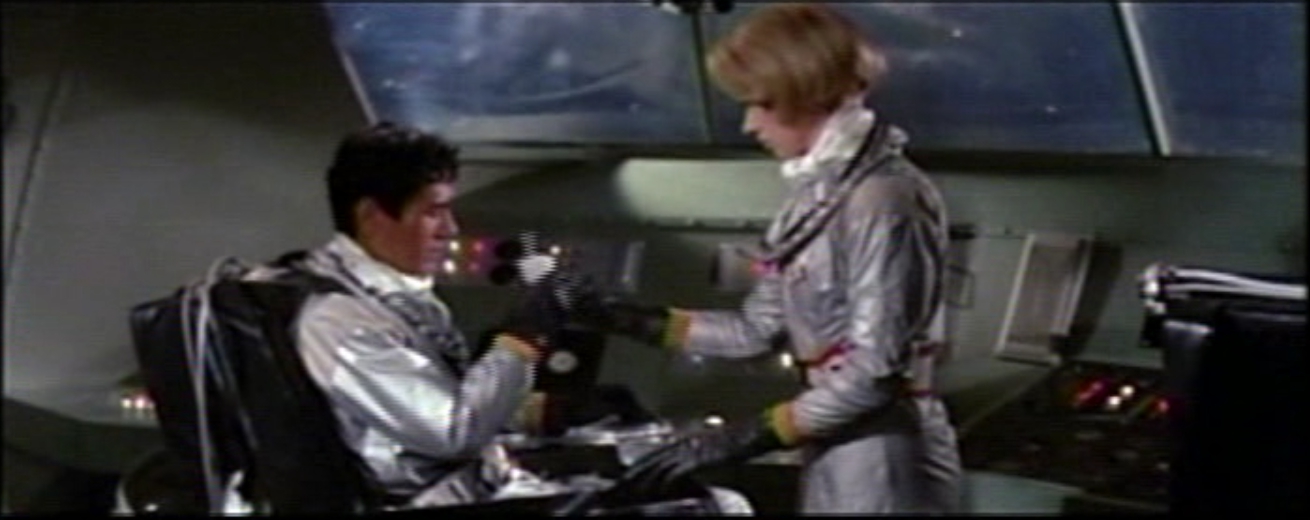
The Lunar colony AAB Gamma aborts to has been established so long that the inhaitants smoke, raise apples, and even have a hot tub and hot showers. This allows Lisa and her rival Mickiko share a tame but titillating shower scene.
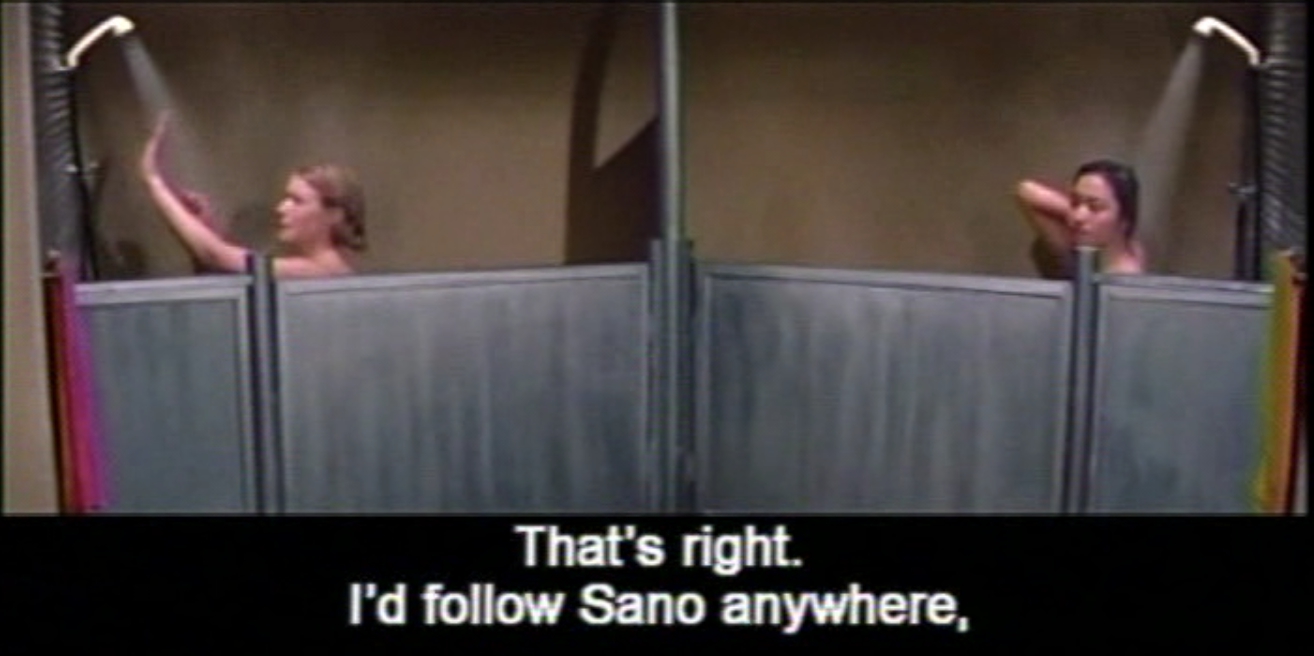
Once AAB Gamma gets back underway to Mars, it's buzzed by a UFO, and then discovers that the engine has developed some lumps, as if it had gotten glowing Space Herpes. It's collected and kept in a vacuum, and brought back to Earth. There, it melts the container, and then goes through the floor, in a discovery that's uncomfortably like a section of Ridley Scott's Alien.
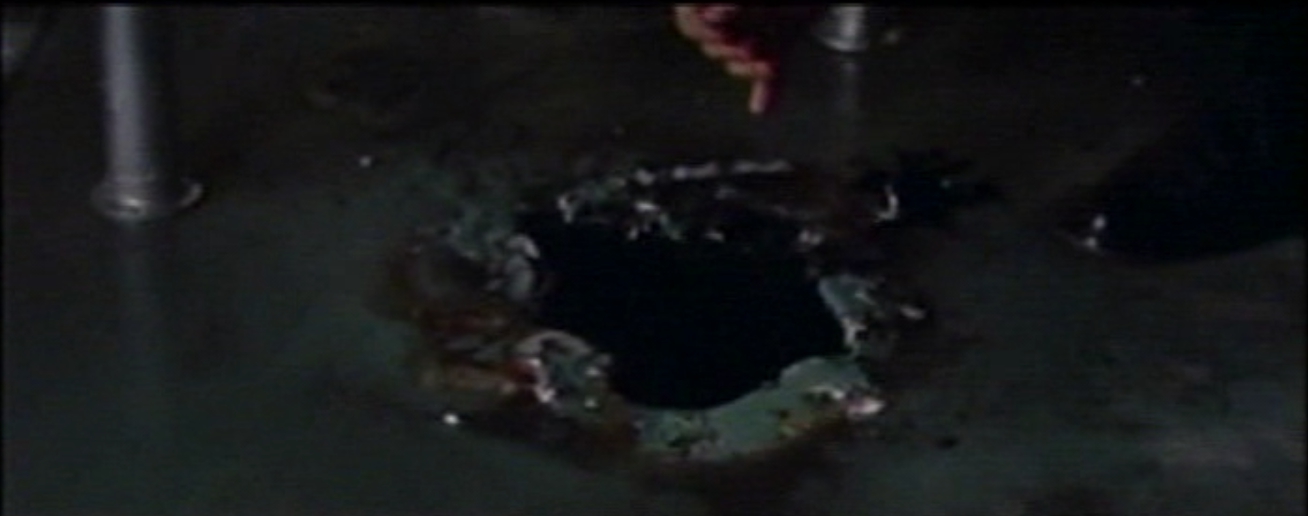
In an interesting twist on the usual gigantic footprint trope that has been used from King Kong to Pacific Rim, Guilala's initial spoor it a tiny track etched into the floor of the lab, giving no indication of the size it will eventually achieve. The gigantic footprint is later discovered, giving the characters the link between the huge monster and what escaped from their lab. Guilala is often referred to as giant poultry, and that's no accident. When viewing the small footprint, it is compared to a three-toed chicken footprint.
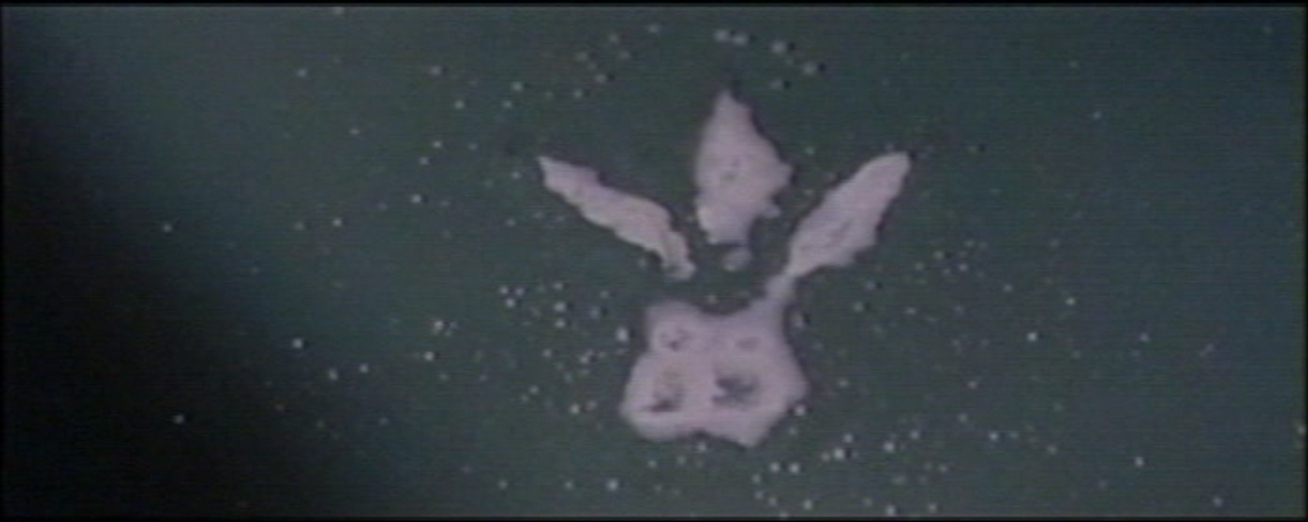
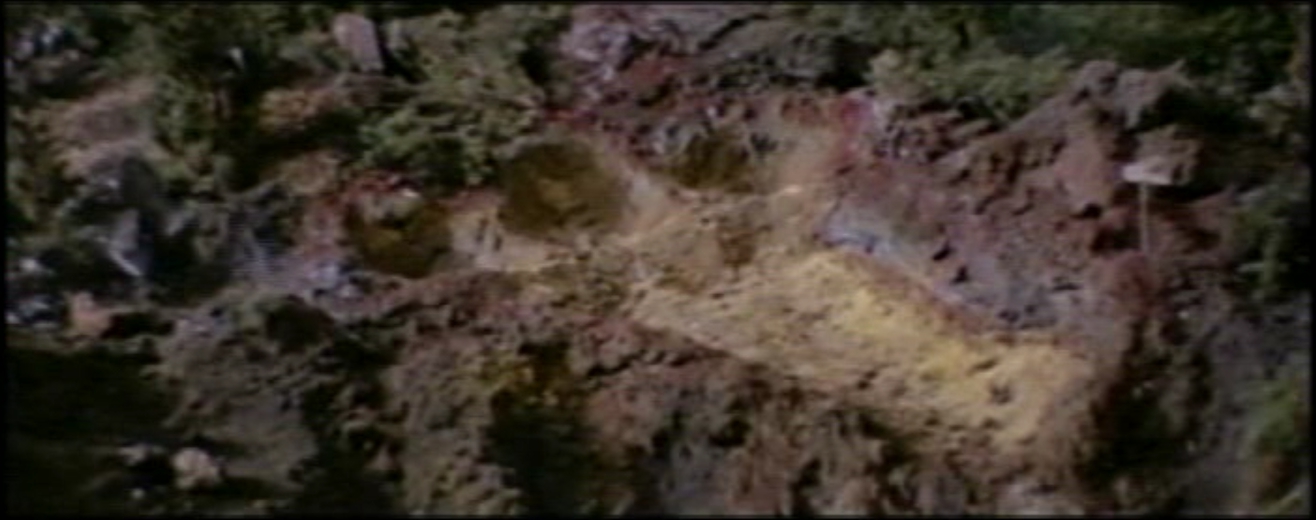
Guilala's initial appearance is very similar to Godzilla's, appearing over the top of a hill to give it scale. This is forty-five minutes into the film, perhaps the longest we've had to wait to see a titular monster in a kaiju film. Guilala's dorsal fin glows, like Godzilla's. Instead of doing so when it's about to breathe atomic fire, Guilala's is sort of an indicator as to its energy level. But it only shows up once, is discussed later, and does not impact the story at all. Like the two deely boppers on its head, the glowing shell seems to be there for visual interest. Guilala's roar seems to be a hoarse guy shouting RAAAAAR, possibly into a coffee can.
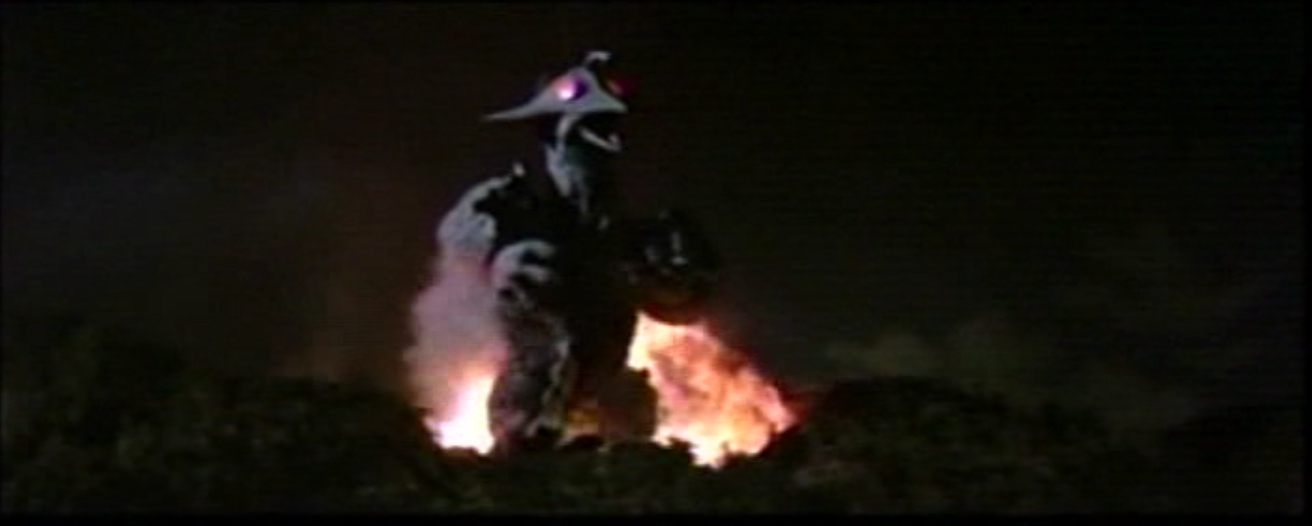
Guilala's initial breakout takes place on Mt. Hakone, which is a bit of an odd place for a space agency, unless it's been deliberately located on the Izu Penninsula. Still, it's quite close to all monster's favorite stoming ground, Tokyo. Scenes of people fleeing while Guilala marches on Tokyo are brief. The film isn't interested in showing us the human cost of the monster's rampage.
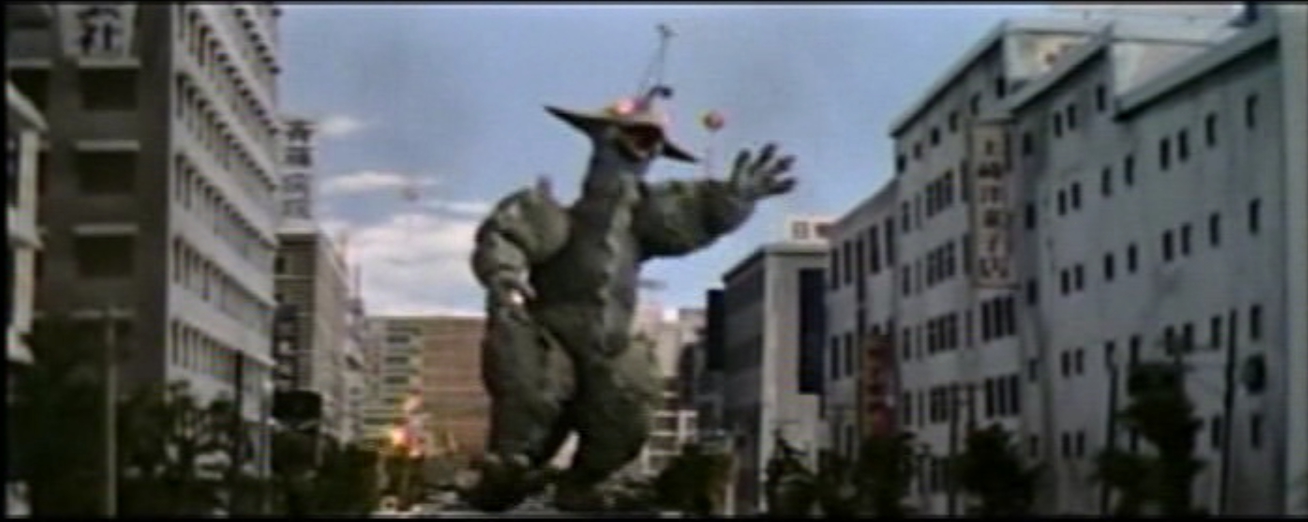
The military is, of course, completely ineffective. Guilala stomps on tanks, blows fireballs at them, and swats Starfighters out of the sky, even though they shouldn't get close enough to let it reach them. Two smash straight into Guilala's head.
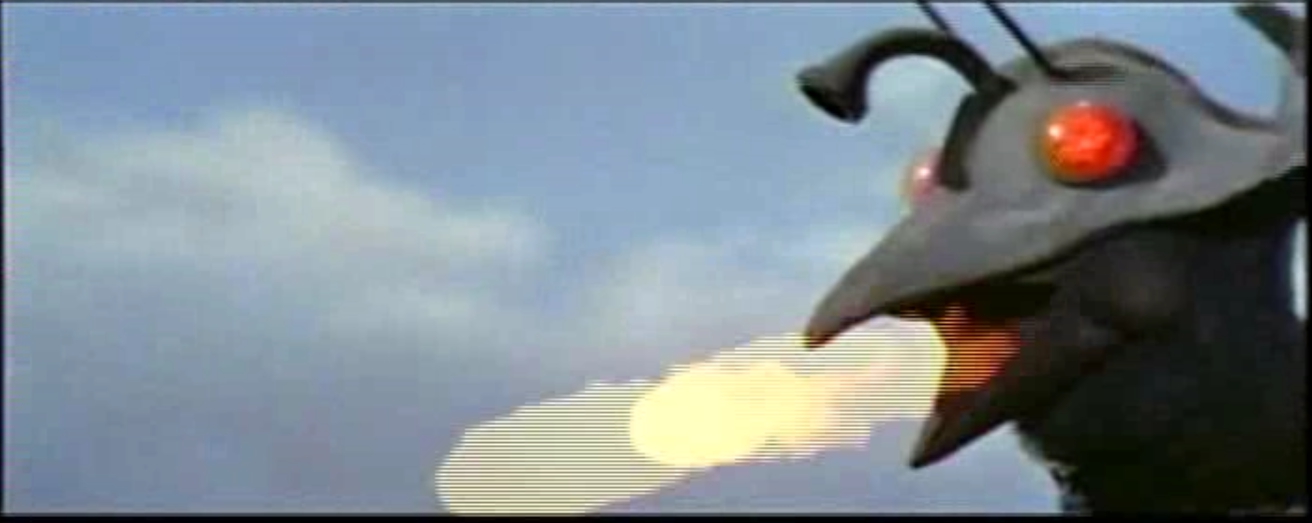
Shochiku is not above stealing a few bits from their favorite kaiju films. The military deploys their own version of the heat ray/maser shown in War of the Gargantuas and several subsequent Toho productions.

But there are some innovations, which is why it's always interesting to watch a new studio attempt a man in a rubber suit film. As it later echoed in Pacific Rim, Guilala picks up an oil tanker and throws it.
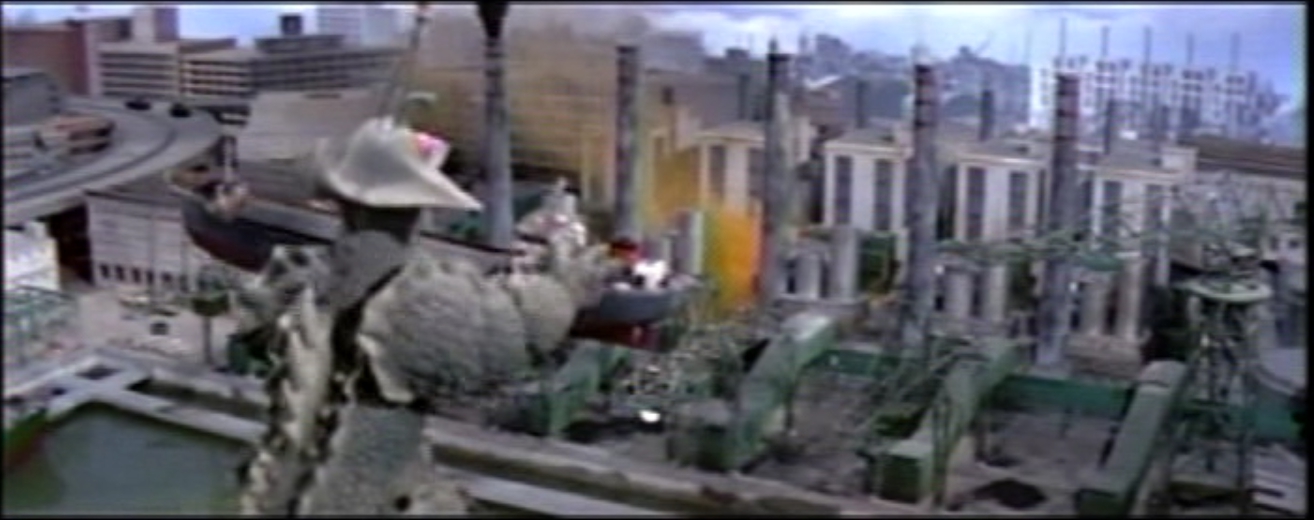
Of course, the monster must have a weakness, and Guilala's is the ore that encased it while in space. This is recreated as the jaw-breaking Guilalanium, which of course proves to be the giant monster's downfall. Like Gamera, Guilala is after energy. Once it has got enough, it turns into a huge, red ball and floats off. Because just having fire breath and some sort of glowing energy shield isn't enough.
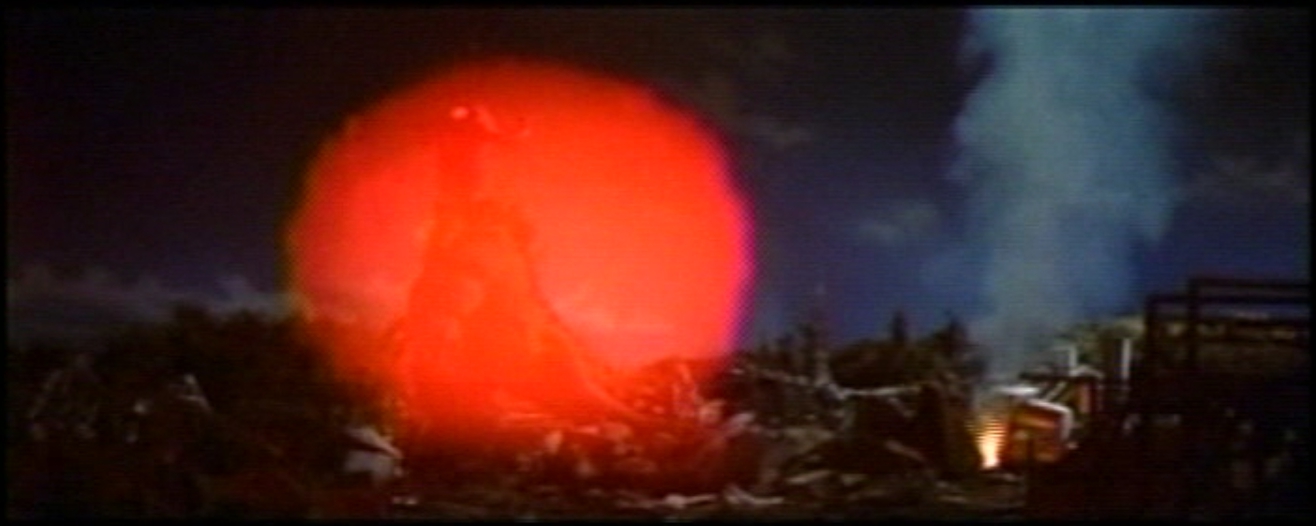
Ultimately, the monster's hunger for energy is its downfall. It is lured away from the Fuji Aeronautical Flight Center by a pair of guys pulling a reactor core on a jeep. This gives everyone time to load their air squadrons with the Guilalanium. As they pelt it with missiles, the monster begins to foam, as if they were hitting it with cream pies. In a spectacular bit of poor editing, as Guilala is layered in foam we cut back to a pair of suits. “No effect yet,” one tells the other. Guilala, coated in shaving foam at this point, lets out a last fireball, destroying one more plane, then shrinks under a blanket of foam until it's once again a small oval.
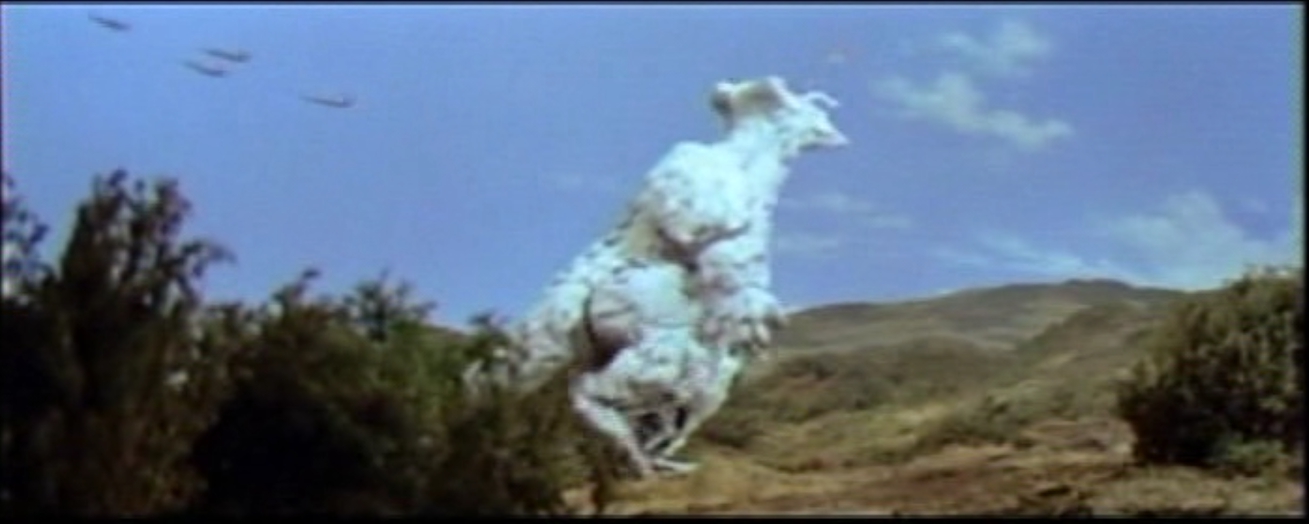
The tiny remnant is placed in a rocket and sent into space. And everything is all better.
Giant Space Monster Guilala is a faltering first step by a studio that had never made a monster film before. It can't decide what it wants to be, a space adventure or a monster movie, and is unsatisfying in either. But it's fascinating for it's craziness. Loading the nuclear fuel into the back of a station wagon? Guilala's unexplained and unnecessary ability to turn into a ball of energy? AAB Gamma's plot-consuming back and forth of to the Moon, and then getting rescued. Which would be fine in a space movie. That's why people go to see a space movie. But as the lead-in to Sometimes I feel like this film was two different pitch scrips that were inexpertly stitched together to form one science fiction movie that was true to neither premise.
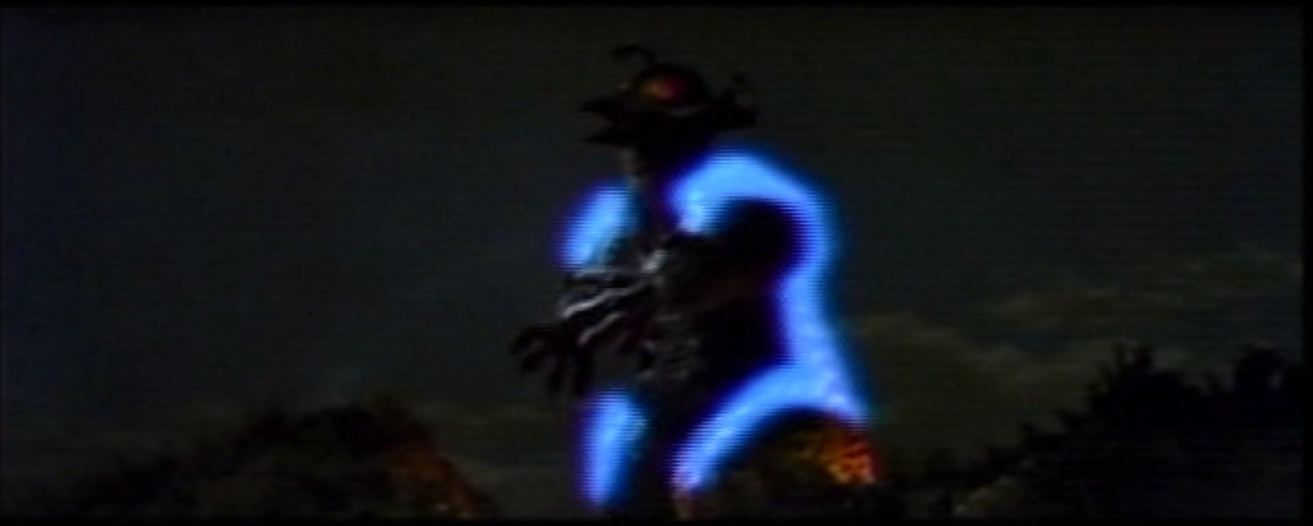
Guilala's rampage is pretty good, and it steps back to Toho's older films, with the planes flying close enough to be swatted down. And there is a bit more interaction with the scenery, specifically when it throws an oil tanker into the cityscape. Unfortunately, they keep cutting away from it, to pursue the story of the humans looking for a way to defeat it. Longer blocks of both, I think, would have kept my attention better.
I hope you have enjoyed your monstrous helping of Thanksgiving turkey. Next, another Japanese studio, Nikkatsu, tries their hand at the genre.

Released in the US as The X From Outer Space, Giant Space Monster Guilala (1967) is the only giant monster film from Japanese film studio Shochiku. It starts off with a lounge-act song over the initial credits. Which is a heck of a thing, especially as the film exhorts the listener to embrace the twinkling future. Given that this is a giant monster film, I cannot help but think that this is somewhat at odds with the embrace of future technology, since many kaiju films are about humanity being punished for scientific transgressions.
For the first time since the 1965 Gamera, this is a rampage movie. As with virtually every other franchise, thism, the first film, has the monster alone against the military and the team of scientists. Guilala does return, in 2009, with Monster X Strikes Back.

The film follows the Fuji Aeronautical Flight Center, the sort of agency that cropped up with regularity in space-race era films. Our first experience is watching four white jumpsuited figures carry enriched nuclear fuel and put it in the back of a station wagon. If that's not space-age professionalism, I don't know what is. This space agency is launching missions to Mars, and anticipating the Galactic Ghoul of the 90's, has long a number of missions previously. Of course, the lost missions were all manned, and the spaceship they're sending, AAB Gamma the agency's first nuclear ship, is unarmed. What could possibly go wrong?

The anticipated problem, UFO interferance, happens, and the ship has to divert to the lunar base because Dr. Shioda has gotten ill from the UFO's approach. And who has to tend his fevered brow and brng him a drink? Why Lisa, the blonde, and the only woman on the crew. Huh. Blonde Lisa is also involved in a love traigle with the Sano, captain of AAB Gamma, who thinks he likes her, but really belongs with Michiko. Despite this early, dismissive treatment, the character of Lisa has a lot of agency, and that's a welcome relief from most kaiju films, which shove the female characters into stereotypical and passive roles. In fact, she is the discoverer of just about all the research that defeats Guilala will come from her. But she starts out as a Space Stewartess.

The Lunar colony AAB Gamma aborts to has been established so long that the inhaitants smoke, raise apples, and even have a hot tub and hot showers. This allows Lisa and her rival Mickiko share a tame but titillating shower scene.

Once AAB Gamma gets back underway to Mars, it's buzzed by a UFO, and then discovers that the engine has developed some lumps, as if it had gotten glowing Space Herpes. It's collected and kept in a vacuum, and brought back to Earth. There, it melts the container, and then goes through the floor, in a discovery that's uncomfortably like a section of Ridley Scott's Alien.

In an interesting twist on the usual gigantic footprint trope that has been used from King Kong to Pacific Rim, Guilala's initial spoor it a tiny track etched into the floor of the lab, giving no indication of the size it will eventually achieve. The gigantic footprint is later discovered, giving the characters the link between the huge monster and what escaped from their lab. Guilala is often referred to as giant poultry, and that's no accident. When viewing the small footprint, it is compared to a three-toed chicken footprint.


Guilala's initial appearance is very similar to Godzilla's, appearing over the top of a hill to give it scale. This is forty-five minutes into the film, perhaps the longest we've had to wait to see a titular monster in a kaiju film. Guilala's dorsal fin glows, like Godzilla's. Instead of doing so when it's about to breathe atomic fire, Guilala's is sort of an indicator as to its energy level. But it only shows up once, is discussed later, and does not impact the story at all. Like the two deely boppers on its head, the glowing shell seems to be there for visual interest. Guilala's roar seems to be a hoarse guy shouting RAAAAAR, possibly into a coffee can.

Guilala's initial breakout takes place on Mt. Hakone, which is a bit of an odd place for a space agency, unless it's been deliberately located on the Izu Penninsula. Still, it's quite close to all monster's favorite stoming ground, Tokyo. Scenes of people fleeing while Guilala marches on Tokyo are brief. The film isn't interested in showing us the human cost of the monster's rampage.

The military is, of course, completely ineffective. Guilala stomps on tanks, blows fireballs at them, and swats Starfighters out of the sky, even though they shouldn't get close enough to let it reach them. Two smash straight into Guilala's head.

Shochiku is not above stealing a few bits from their favorite kaiju films. The military deploys their own version of the heat ray/maser shown in War of the Gargantuas and several subsequent Toho productions.

But there are some innovations, which is why it's always interesting to watch a new studio attempt a man in a rubber suit film. As it later echoed in Pacific Rim, Guilala picks up an oil tanker and throws it.

Of course, the monster must have a weakness, and Guilala's is the ore that encased it while in space. This is recreated as the jaw-breaking Guilalanium, which of course proves to be the giant monster's downfall. Like Gamera, Guilala is after energy. Once it has got enough, it turns into a huge, red ball and floats off. Because just having fire breath and some sort of glowing energy shield isn't enough.

Ultimately, the monster's hunger for energy is its downfall. It is lured away from the Fuji Aeronautical Flight Center by a pair of guys pulling a reactor core on a jeep. This gives everyone time to load their air squadrons with the Guilalanium. As they pelt it with missiles, the monster begins to foam, as if they were hitting it with cream pies. In a spectacular bit of poor editing, as Guilala is layered in foam we cut back to a pair of suits. “No effect yet,” one tells the other. Guilala, coated in shaving foam at this point, lets out a last fireball, destroying one more plane, then shrinks under a blanket of foam until it's once again a small oval.

The tiny remnant is placed in a rocket and sent into space. And everything is all better.
Giant Space Monster Guilala is a faltering first step by a studio that had never made a monster film before. It can't decide what it wants to be, a space adventure or a monster movie, and is unsatisfying in either. But it's fascinating for it's craziness. Loading the nuclear fuel into the back of a station wagon? Guilala's unexplained and unnecessary ability to turn into a ball of energy? AAB Gamma's plot-consuming back and forth of to the Moon, and then getting rescued. Which would be fine in a space movie. That's why people go to see a space movie. But as the lead-in to Sometimes I feel like this film was two different pitch scrips that were inexpertly stitched together to form one science fiction movie that was true to neither premise.

Guilala's rampage is pretty good, and it steps back to Toho's older films, with the planes flying close enough to be swatted down. And there is a bit more interaction with the scenery, specifically when it throws an oil tanker into the cityscape. Unfortunately, they keep cutting away from it, to pursue the story of the humans looking for a way to defeat it. Longer blocks of both, I think, would have kept my attention better.
I hope you have enjoyed your monstrous helping of Thanksgiving turkey. Next, another Japanese studio, Nikkatsu, tries their hand at the genre.
Thursday, November 21, 2013
The Unlikely vs the More Unlikely: Gamera vs Gyaos
Gamera vs Gyaos is the footprint on which future Gamera films will be based. A child actor as the main character, ridiculous action, and a goofy opponent. Gyaos is, like Godzilla and Gamera himself, an ancient creature awakened into the modern time. Most later Gamera films will involve some sort of alien invader.
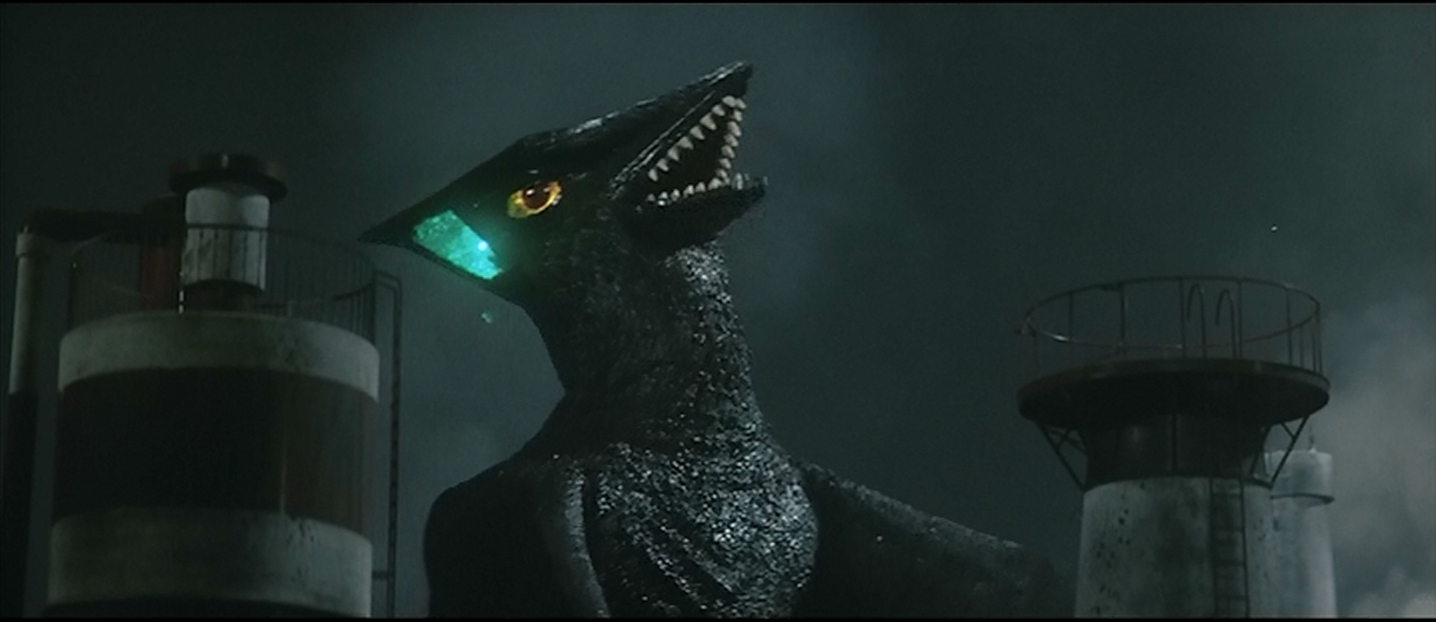
The effects are better than previous enttries from Daiei. After some stock footage of volcanoes, the viewer is presented with a lovely Mt. Fuji eruption in miniature, complete with lava flow. Daiei has been honing their miniature craft, and their experience is showing.
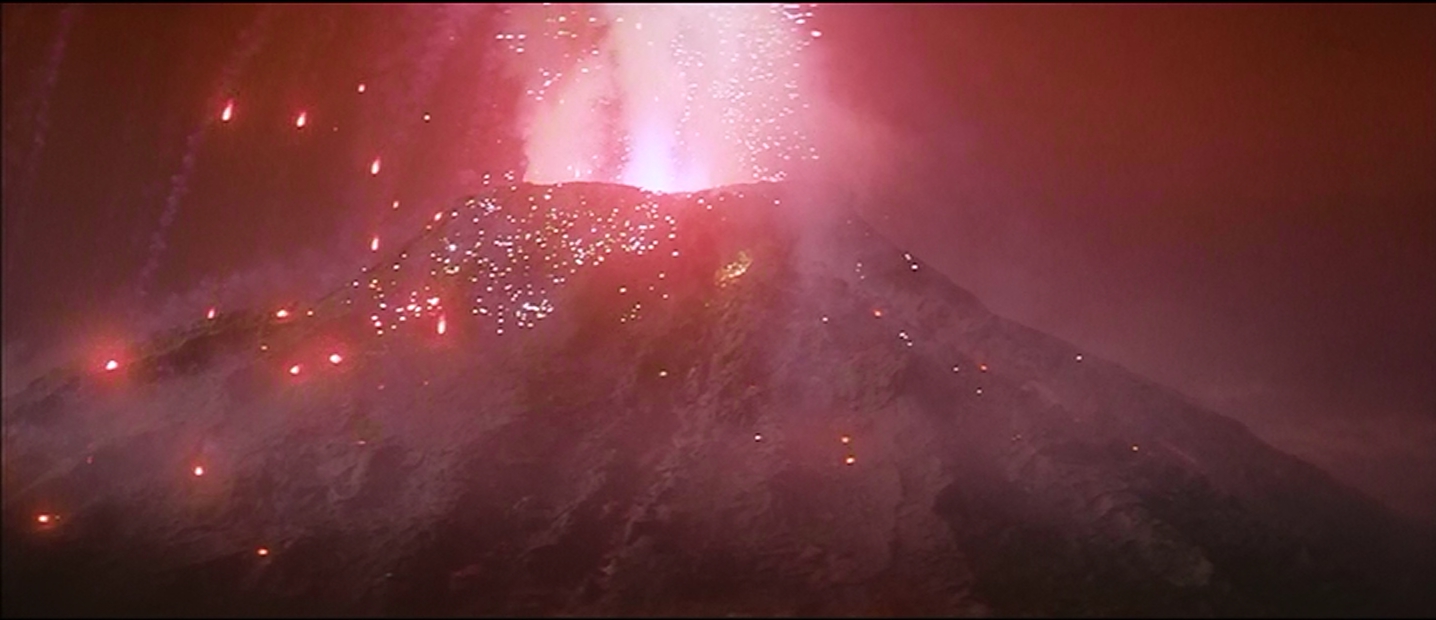
The film owes a moderate amount to Godzilla vs Mothra. First off, the instigator of the human plot is a greedy corporation, this one determinted to drive their road through a village, any cost. We are clearly meant to sympathize with the villagers, although after the initial protest, we find out that they are only resisting to get more money out of the Road Corporation. The Road Corporation laborers are hapless comedy figures who bear the brunt of the villager's displeasure as well as are also meant to be sympathetic. They have no effect on the plot, their time finished when the monsters appear on-screen, and given only a perfonctory closure at the end of the film.
As a team of scientists investigate Gamera's hoped-for death after he throws himself in Mt Fuji, an action echoed when Godzilla gets dropped into Mt. Mihara in The Return of Godzilla, their helicopter is sliced in half by a mysterious ground-based yellow beam. When a group of Starfighters attack, they are also neatly sliced up.

When a group of reporters are taking pictures of Gyaos rampaging through Nagoya, Gyaos's beam slices the car neatly between the diver's and passeneger's side. Except for the engine and the chassis. If you look at the right half of the car, you can see the support strut used instead of the wheel. This particular effect, and that particular bobble, is something that we'll see in another film, also released in 1967.
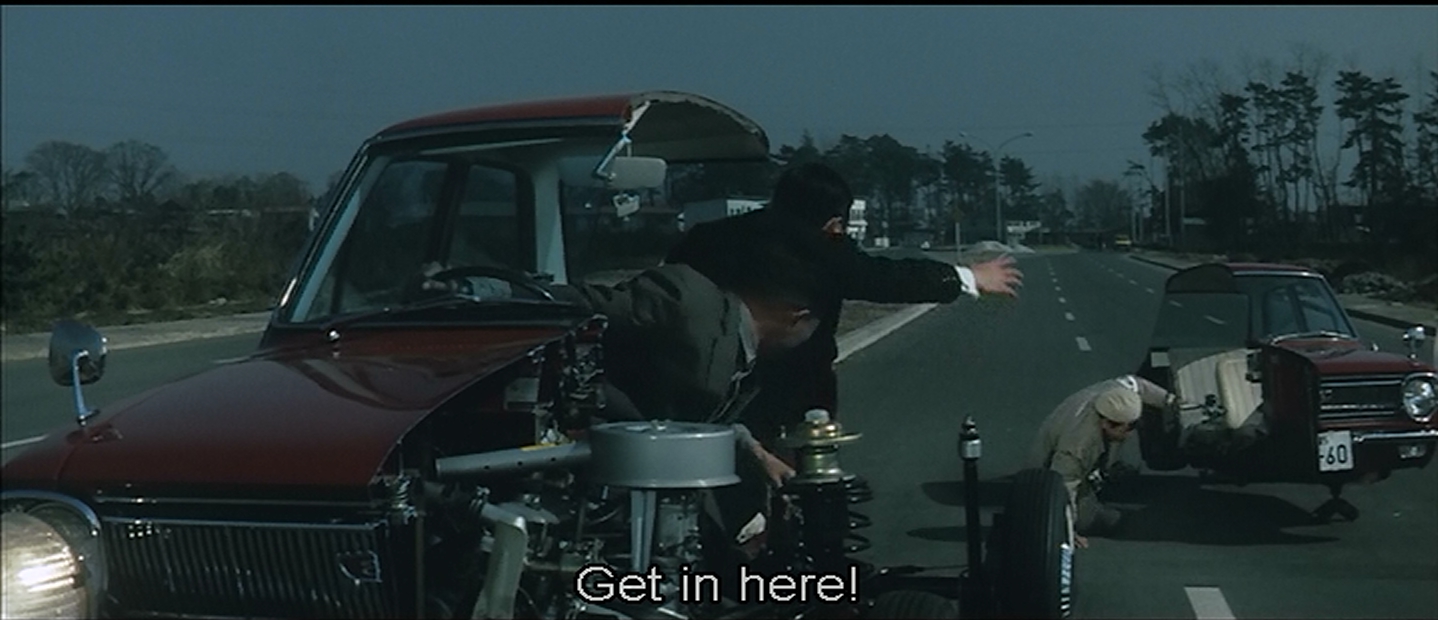
And introducing the Timmy. Eiichi is the name of our precocious and annoying little protagonist, and he does very little to endear himself to the adult viewer. Our first real encounter with him involves a reporter, a slingshot and a stone. The very close camera angles do the kid no favors, we hear his name a lot. He is subsequently involved in just about everything the adults do. From the military plannng session to attack Gyaos to suggesting the plan that ultimately works. There are worse examples of the supercompetent preadolescent character coming in both monster franchises.
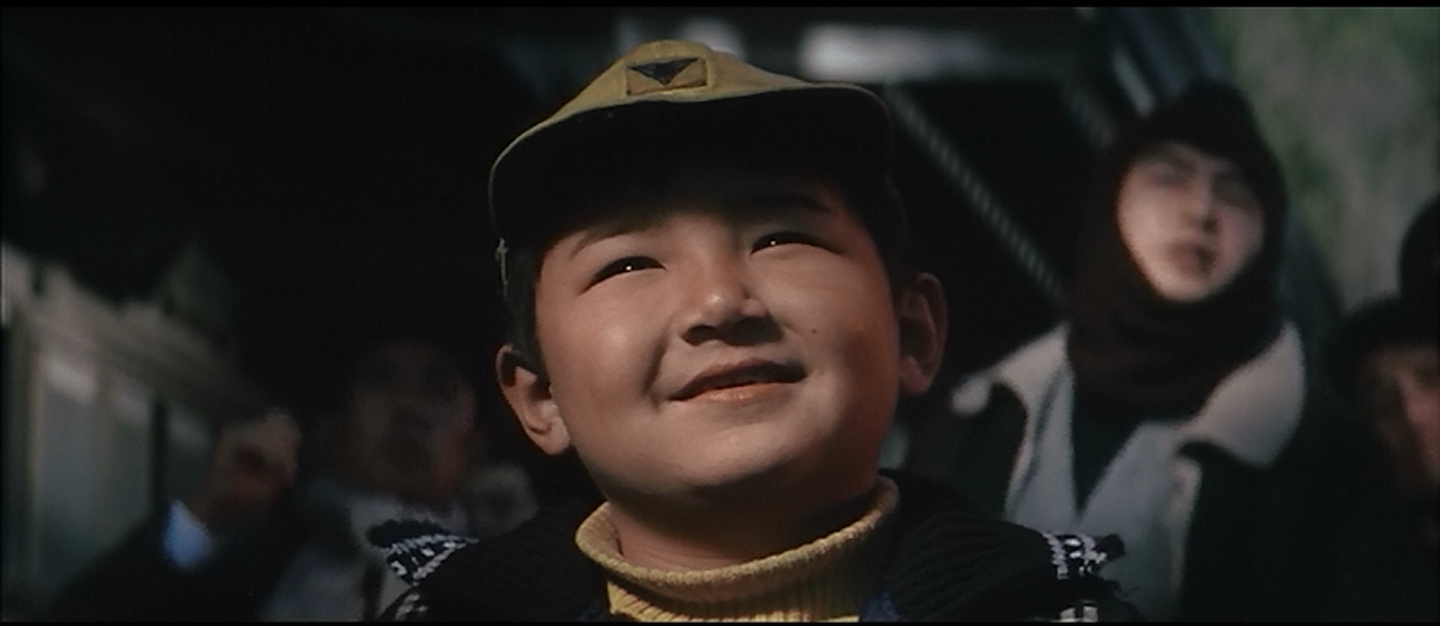
While Gamera films are made explicitly for kids, they do include a lot more bloodletting than the more genteel Godzilla films. Our first glimpse of Gyaos comes when he eats an annoying reporter. When Gamera first arrives on the scene, Gyaos shoots his ultra-sharp beam, and makes Gamera bleed copious amounts of green blood. Gamera replies with his flaming breath, and the initial encounter is a stalemate.
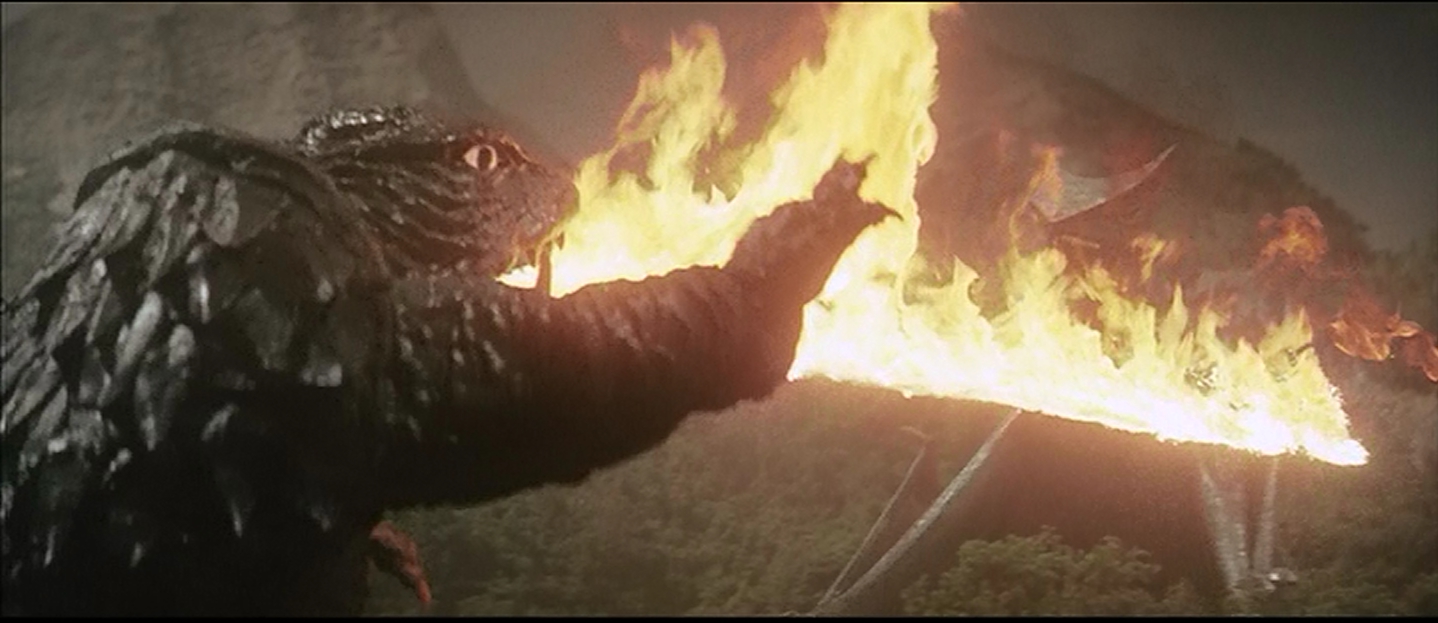
Gyaos is typical of the opponents in the Gamera films. The suit looks cheaper than Godzilla's opponents. Interestingly, it has a pair of weaknesses. One, because of its twin throats, it cannot turn its head. Also, its flesh shrinks from, ultraviolet light. Both of these are ultimately irrelevant, since Gamera dumps its enemy into a volcano. Like Rodan, Gyaos can cause hurricane-force winds with its mighty wings, which is how it defeats the Japanese self-defence forces. After doing so, it takea s flying tour of Nagoya, destroying Nagoya Castle (last seen in Godzila vs Mothra) in the process.
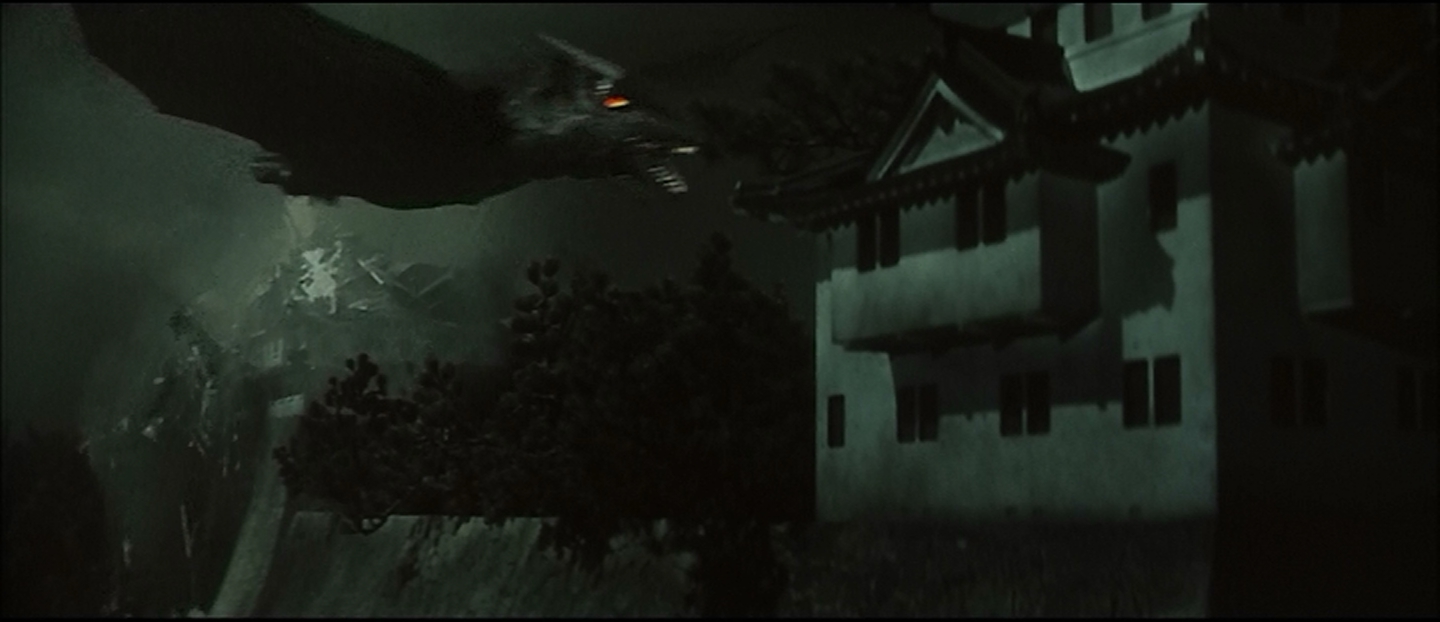
In a second, bloody confrontation (Gyaos's blood is purple), Gamera tears off two of his enemy's toes, which are discovered floating in the bay and hauled to a lab for analysis. Luckily, Gyaos doesn't possess the recuperative powers of Reptilicus. It regenerates the toes, but the toes do not create another Gyaos. After some experimentation, it is determined that Gyaos's flesh shrinks when exposed to ultraviolet light. Like the creature's inability to turn its head, this is not part of Gamera's solution, but it serves to give the humans something to do while Gamera is under the sea, healing his cuts.
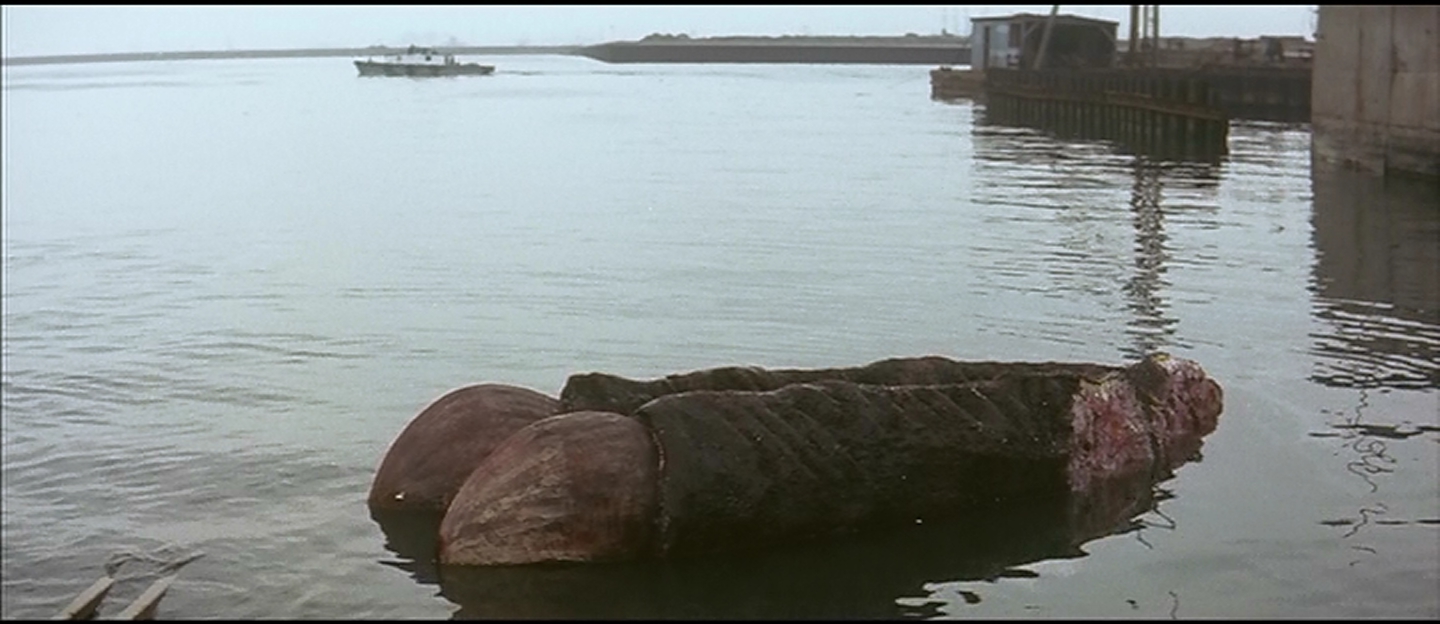
The humans' crazy-ass solution is to get Gyaos, a flying creature, onto a turntable to disorient it. To lure it, scientists will have to create an articifial blood that will lure Gyaos to the spot. Which they do, quite quickly. This is the same wacky logic that led us to multi-ton turtle into space in Gamera. Of course, this fails. The military revs the turntable too high, like the commander melting the relays in Godzilla vs Mothra, and the motor shorts out allowing Gyaos to escape. Poisoning the bait, I have to assume, was too technically complex.
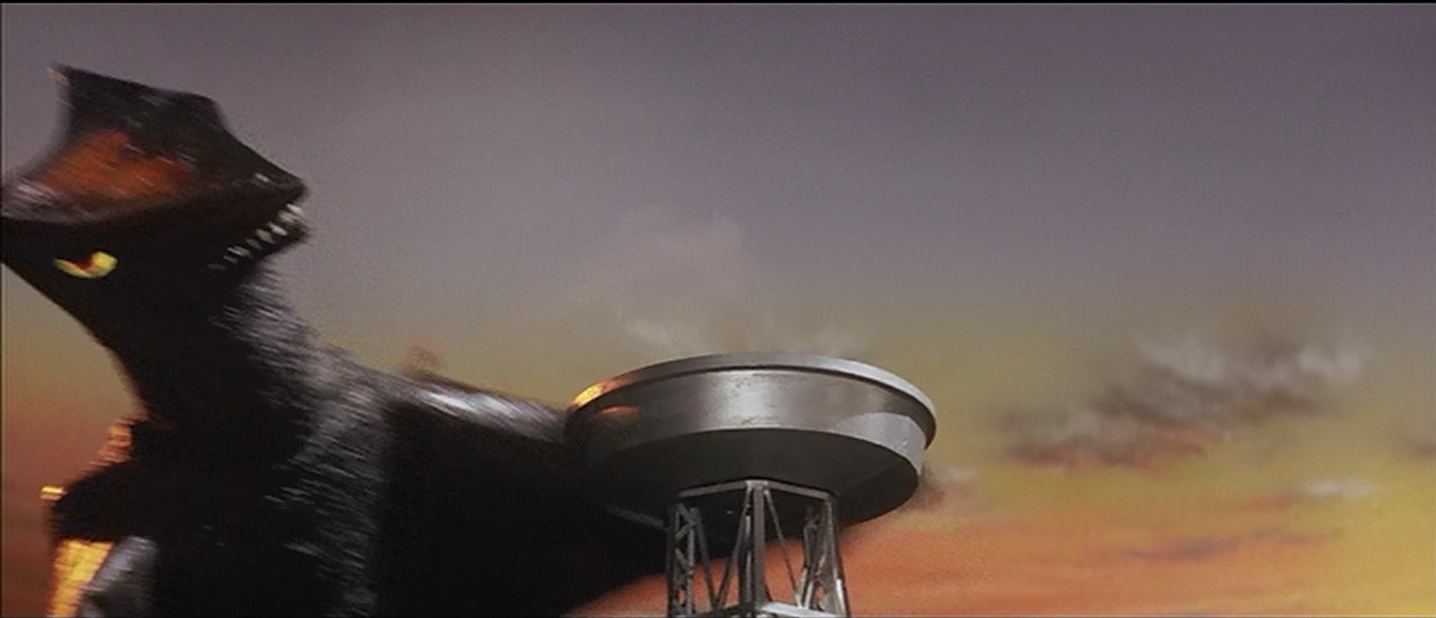
The next awesome plan, suggested by Eiichi, is to set a forest fire, since Gyaos doesn't like fire, and Gamera loves it. Of course, it works, and the two gigantic monsters have their final showdown in a somewhat less impressive forest fire than Frankenstein and Barugon got. Oh, and Gyaos has some sort of fire-extinguishing mist that it sprays from it's abdomen. Gamera is able to stop Gyaos's most dangerous weapon, the sonic beam, by throwing a rock into its mouth. After that he gets a grip on Gyaos's neck, and hauls him into a volcano. Vulnerability to ultraviolet radiation? Unhelpful. Discovery that Gyaos can't turn his head? Also unhelpful. And then it's a kids' chorus singing Gamera's praises as we see the giant turtle's greatest hits behind the credits.
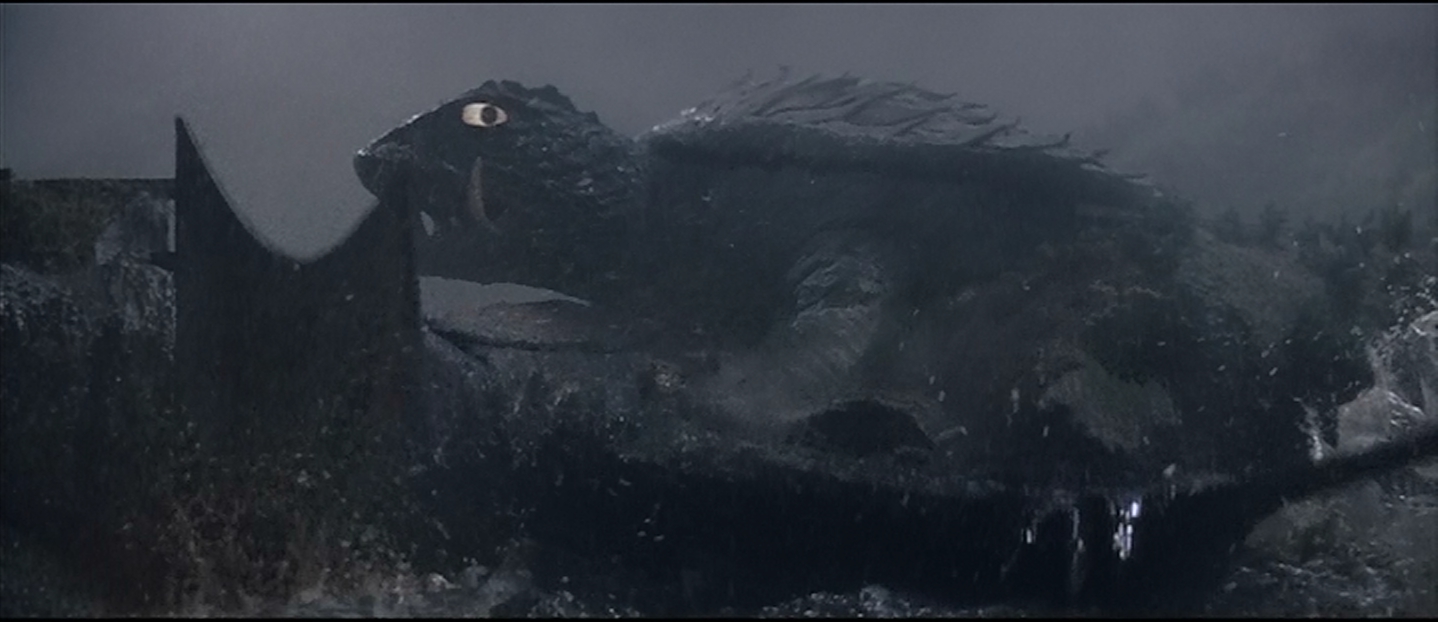
Gamera just unable to hold my interest. Yeah, it's a giant monster, but the human stories are so astonishingly goofy. The concentration on the kid, the uselessness of all adults, fact that Eiichi is the only person who can make a worthwhile contribution to the defense of Japan, all make me roll my eyes. Yes, I understand that it was a terrible time in writing and film history. The dead-end plots that point out Gyaos' vulnerabilities and then do nothing with them. Showing us Gyaos's weird powers (it can emit flame-retardant?) and then not using them for anything significant. All of these disappoint me, because Checkov's Gun is a wonderful thing when it is handled properly. But that requires effort on the part of the writer. Godzilla films of the era aren't much better. I really didn't like Son of Godzilla. There's no subtlety, no subtext to these films. They are being churned out on a schedule, which means that if a good idea can't be had, a mediocre one will do, and a bad one will get used if a mediocre one isn't available.
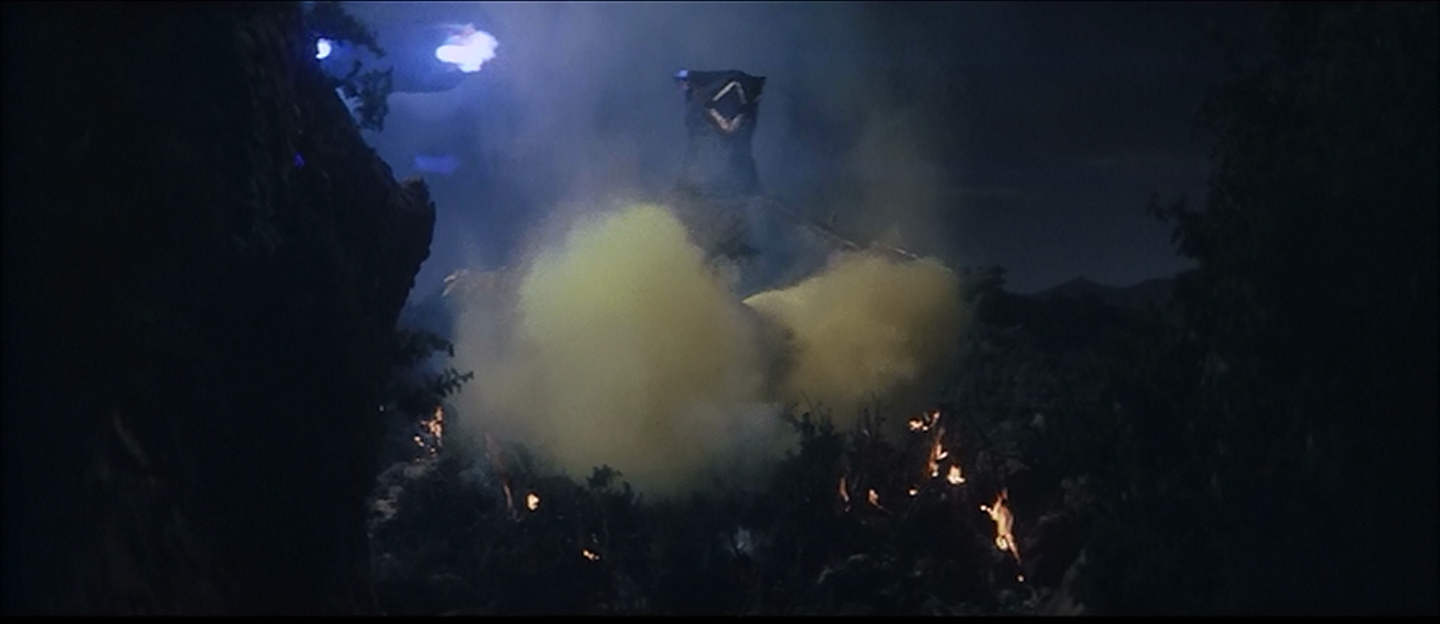
Next week, the biggest Thanksgiving Turkey to ever grace the screen!

The effects are better than previous enttries from Daiei. After some stock footage of volcanoes, the viewer is presented with a lovely Mt. Fuji eruption in miniature, complete with lava flow. Daiei has been honing their miniature craft, and their experience is showing.

The film owes a moderate amount to Godzilla vs Mothra. First off, the instigator of the human plot is a greedy corporation, this one determinted to drive their road through a village, any cost. We are clearly meant to sympathize with the villagers, although after the initial protest, we find out that they are only resisting to get more money out of the Road Corporation. The Road Corporation laborers are hapless comedy figures who bear the brunt of the villager's displeasure as well as are also meant to be sympathetic. They have no effect on the plot, their time finished when the monsters appear on-screen, and given only a perfonctory closure at the end of the film.
As a team of scientists investigate Gamera's hoped-for death after he throws himself in Mt Fuji, an action echoed when Godzilla gets dropped into Mt. Mihara in The Return of Godzilla, their helicopter is sliced in half by a mysterious ground-based yellow beam. When a group of Starfighters attack, they are also neatly sliced up.

When a group of reporters are taking pictures of Gyaos rampaging through Nagoya, Gyaos's beam slices the car neatly between the diver's and passeneger's side. Except for the engine and the chassis. If you look at the right half of the car, you can see the support strut used instead of the wheel. This particular effect, and that particular bobble, is something that we'll see in another film, also released in 1967.

And introducing the Timmy. Eiichi is the name of our precocious and annoying little protagonist, and he does very little to endear himself to the adult viewer. Our first real encounter with him involves a reporter, a slingshot and a stone. The very close camera angles do the kid no favors, we hear his name a lot. He is subsequently involved in just about everything the adults do. From the military plannng session to attack Gyaos to suggesting the plan that ultimately works. There are worse examples of the supercompetent preadolescent character coming in both monster franchises.

While Gamera films are made explicitly for kids, they do include a lot more bloodletting than the more genteel Godzilla films. Our first glimpse of Gyaos comes when he eats an annoying reporter. When Gamera first arrives on the scene, Gyaos shoots his ultra-sharp beam, and makes Gamera bleed copious amounts of green blood. Gamera replies with his flaming breath, and the initial encounter is a stalemate.

Gyaos is typical of the opponents in the Gamera films. The suit looks cheaper than Godzilla's opponents. Interestingly, it has a pair of weaknesses. One, because of its twin throats, it cannot turn its head. Also, its flesh shrinks from, ultraviolet light. Both of these are ultimately irrelevant, since Gamera dumps its enemy into a volcano. Like Rodan, Gyaos can cause hurricane-force winds with its mighty wings, which is how it defeats the Japanese self-defence forces. After doing so, it takea s flying tour of Nagoya, destroying Nagoya Castle (last seen in Godzila vs Mothra) in the process.

In a second, bloody confrontation (Gyaos's blood is purple), Gamera tears off two of his enemy's toes, which are discovered floating in the bay and hauled to a lab for analysis. Luckily, Gyaos doesn't possess the recuperative powers of Reptilicus. It regenerates the toes, but the toes do not create another Gyaos. After some experimentation, it is determined that Gyaos's flesh shrinks when exposed to ultraviolet light. Like the creature's inability to turn its head, this is not part of Gamera's solution, but it serves to give the humans something to do while Gamera is under the sea, healing his cuts.

The humans' crazy-ass solution is to get Gyaos, a flying creature, onto a turntable to disorient it. To lure it, scientists will have to create an articifial blood that will lure Gyaos to the spot. Which they do, quite quickly. This is the same wacky logic that led us to multi-ton turtle into space in Gamera. Of course, this fails. The military revs the turntable too high, like the commander melting the relays in Godzilla vs Mothra, and the motor shorts out allowing Gyaos to escape. Poisoning the bait, I have to assume, was too technically complex.

The next awesome plan, suggested by Eiichi, is to set a forest fire, since Gyaos doesn't like fire, and Gamera loves it. Of course, it works, and the two gigantic monsters have their final showdown in a somewhat less impressive forest fire than Frankenstein and Barugon got. Oh, and Gyaos has some sort of fire-extinguishing mist that it sprays from it's abdomen. Gamera is able to stop Gyaos's most dangerous weapon, the sonic beam, by throwing a rock into its mouth. After that he gets a grip on Gyaos's neck, and hauls him into a volcano. Vulnerability to ultraviolet radiation? Unhelpful. Discovery that Gyaos can't turn his head? Also unhelpful. And then it's a kids' chorus singing Gamera's praises as we see the giant turtle's greatest hits behind the credits.

Gamera just unable to hold my interest. Yeah, it's a giant monster, but the human stories are so astonishingly goofy. The concentration on the kid, the uselessness of all adults, fact that Eiichi is the only person who can make a worthwhile contribution to the defense of Japan, all make me roll my eyes. Yes, I understand that it was a terrible time in writing and film history. The dead-end plots that point out Gyaos' vulnerabilities and then do nothing with them. Showing us Gyaos's weird powers (it can emit flame-retardant?) and then not using them for anything significant. All of these disappoint me, because Checkov's Gun is a wonderful thing when it is handled properly. But that requires effort on the part of the writer. Godzilla films of the era aren't much better. I really didn't like Son of Godzilla. There's no subtlety, no subtext to these films. They are being churned out on a schedule, which means that if a good idea can't be had, a mediocre one will do, and a bad one will get used if a mediocre one isn't available.

Next week, the biggest Thanksgiving Turkey to ever grace the screen!
Subscribe to:
Posts (Atom)